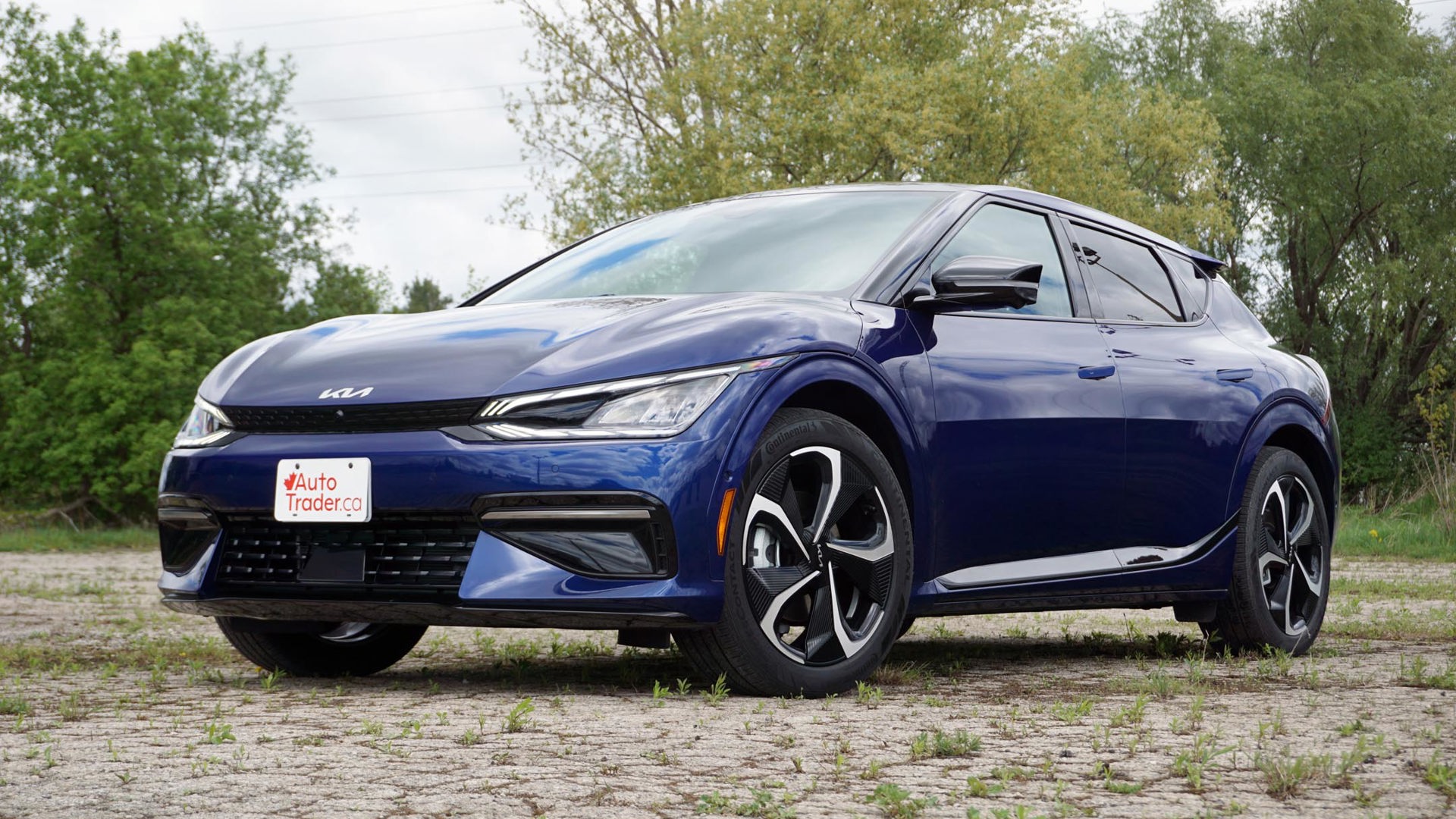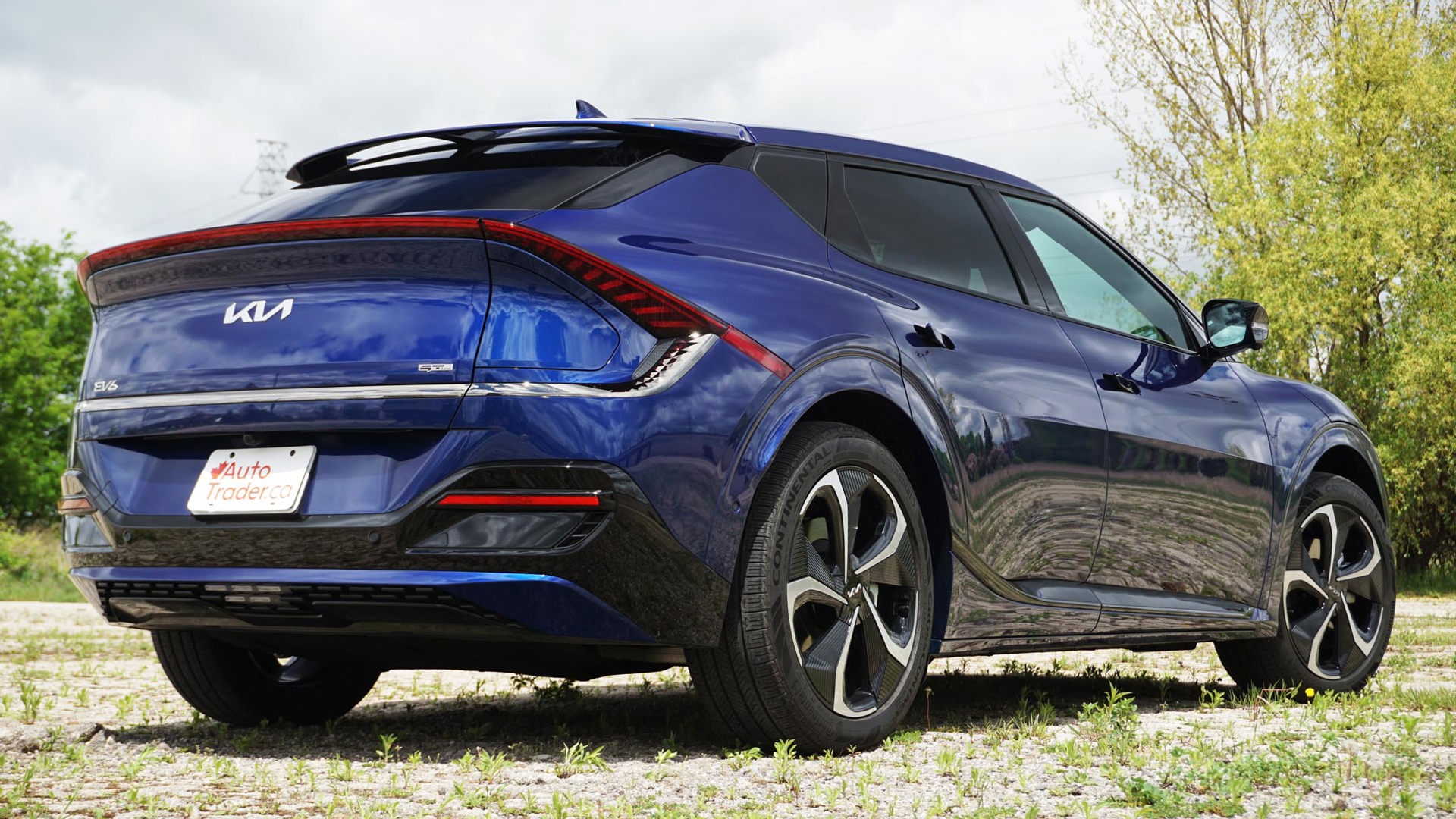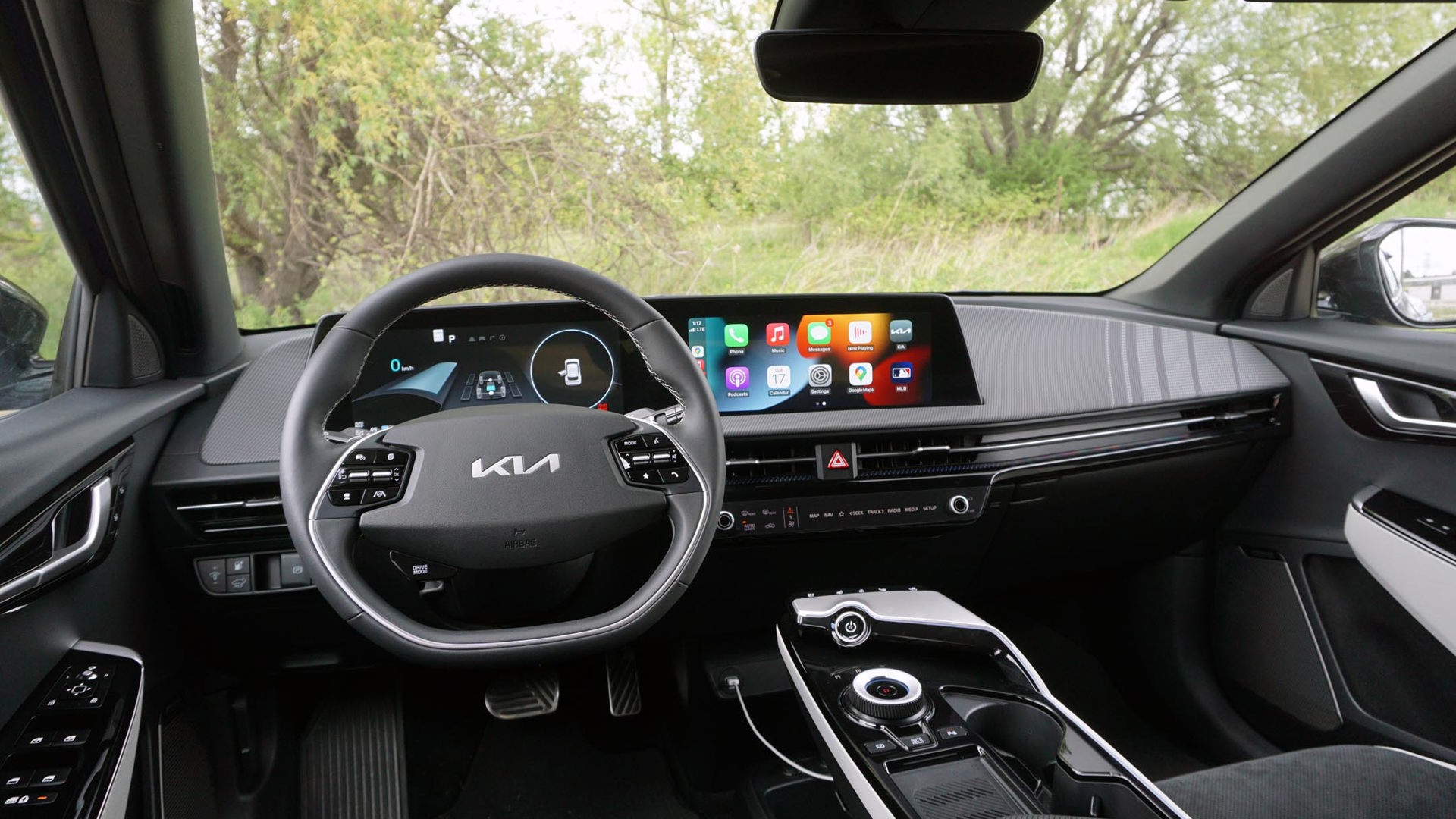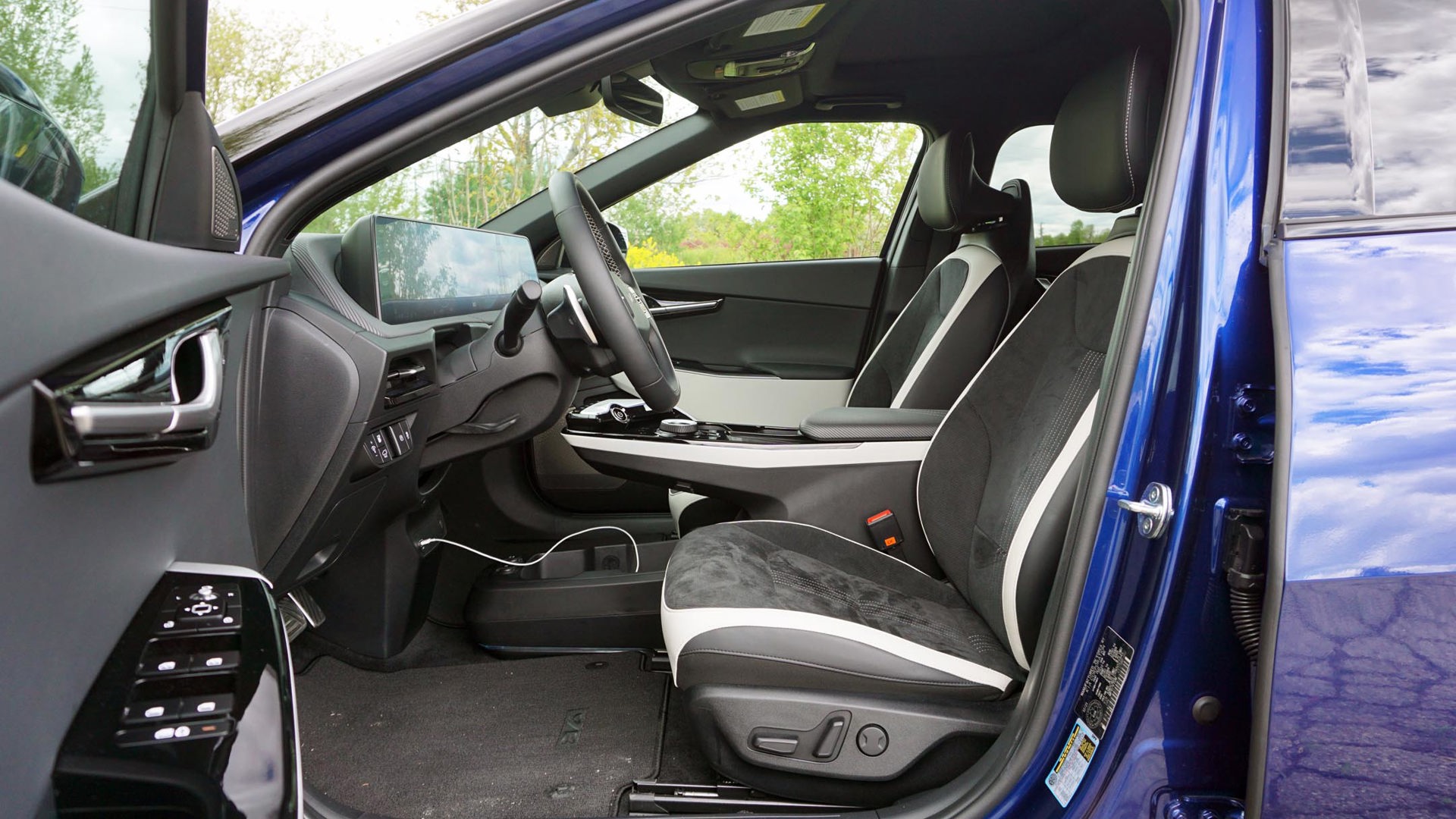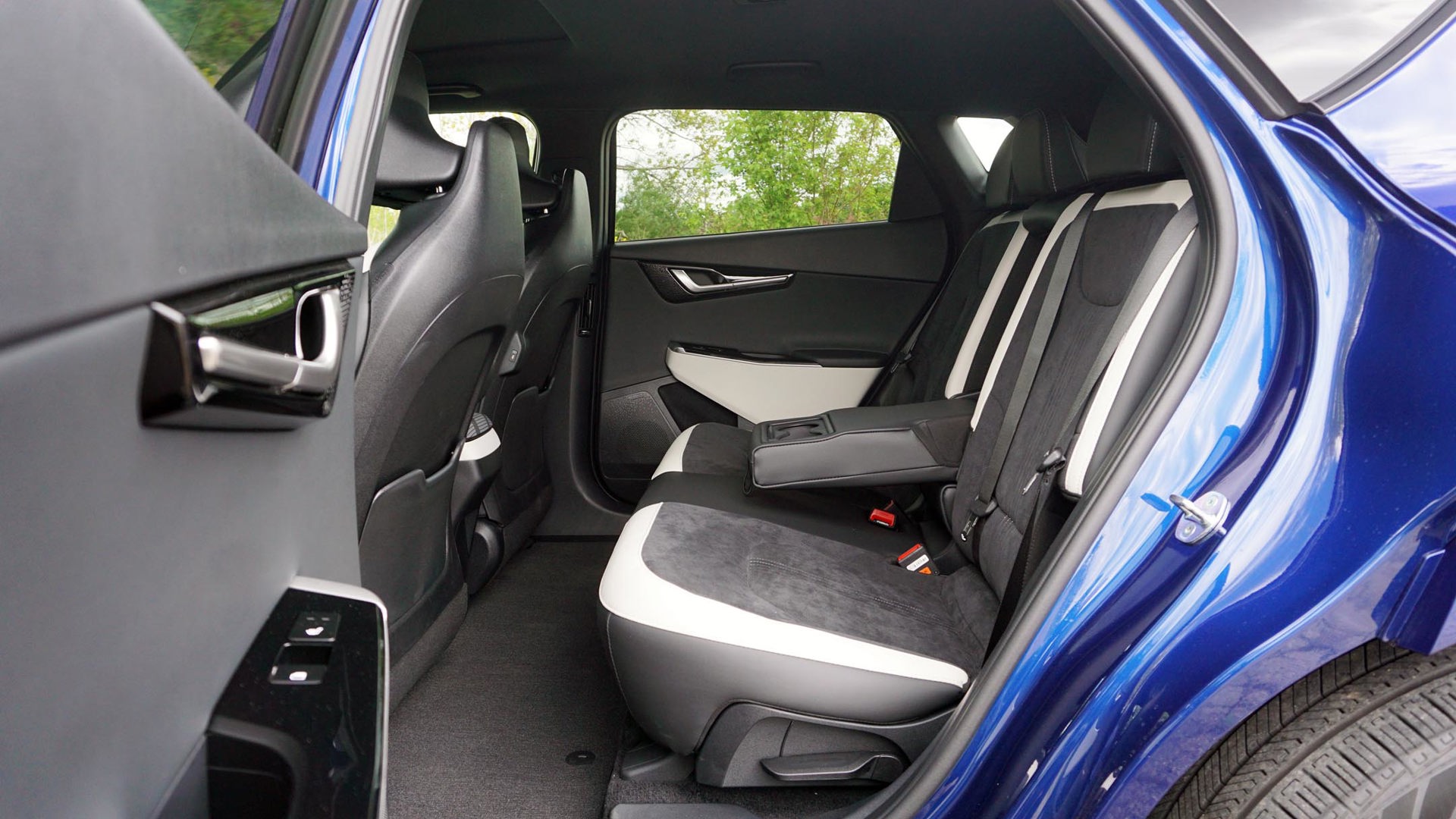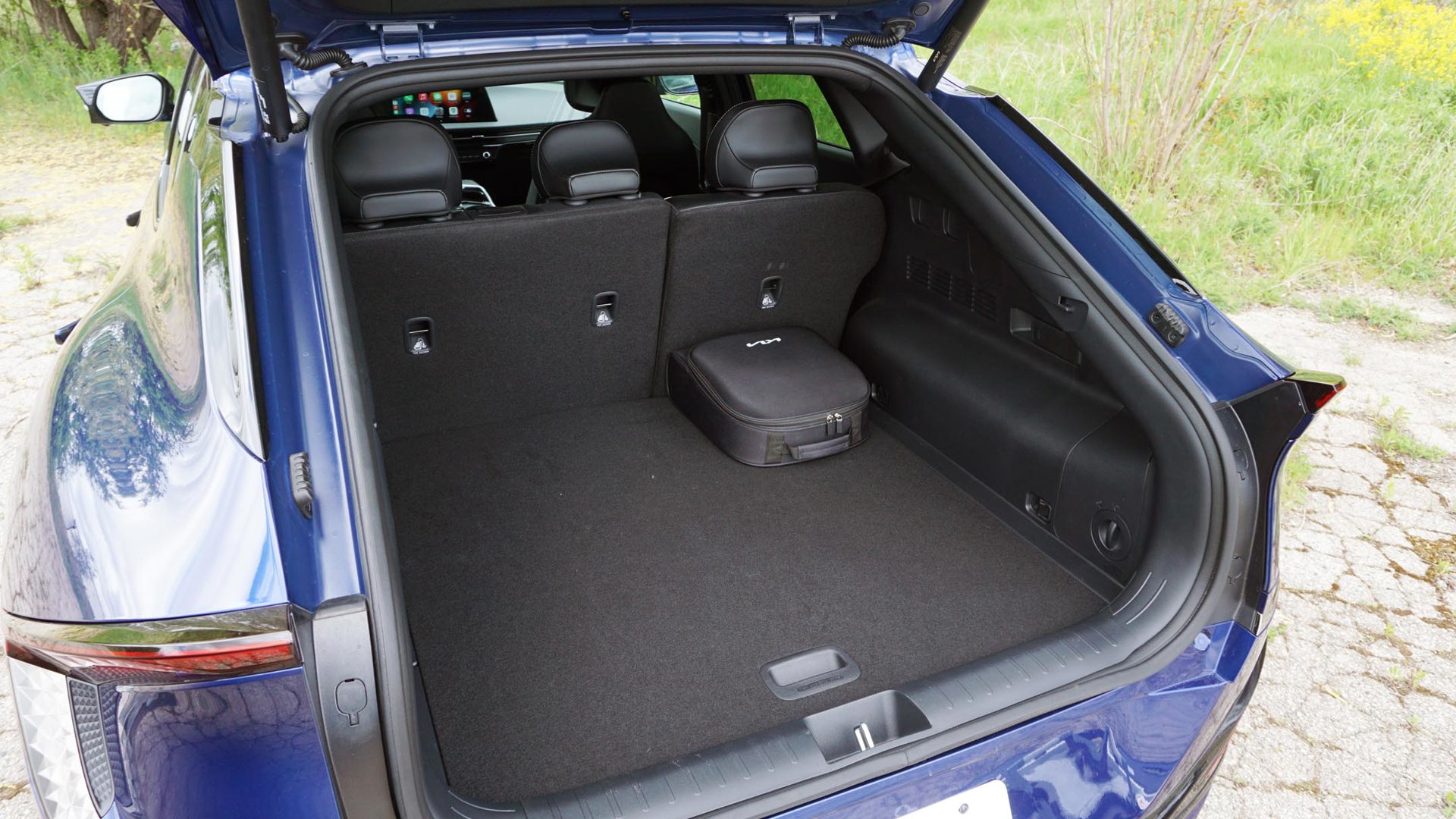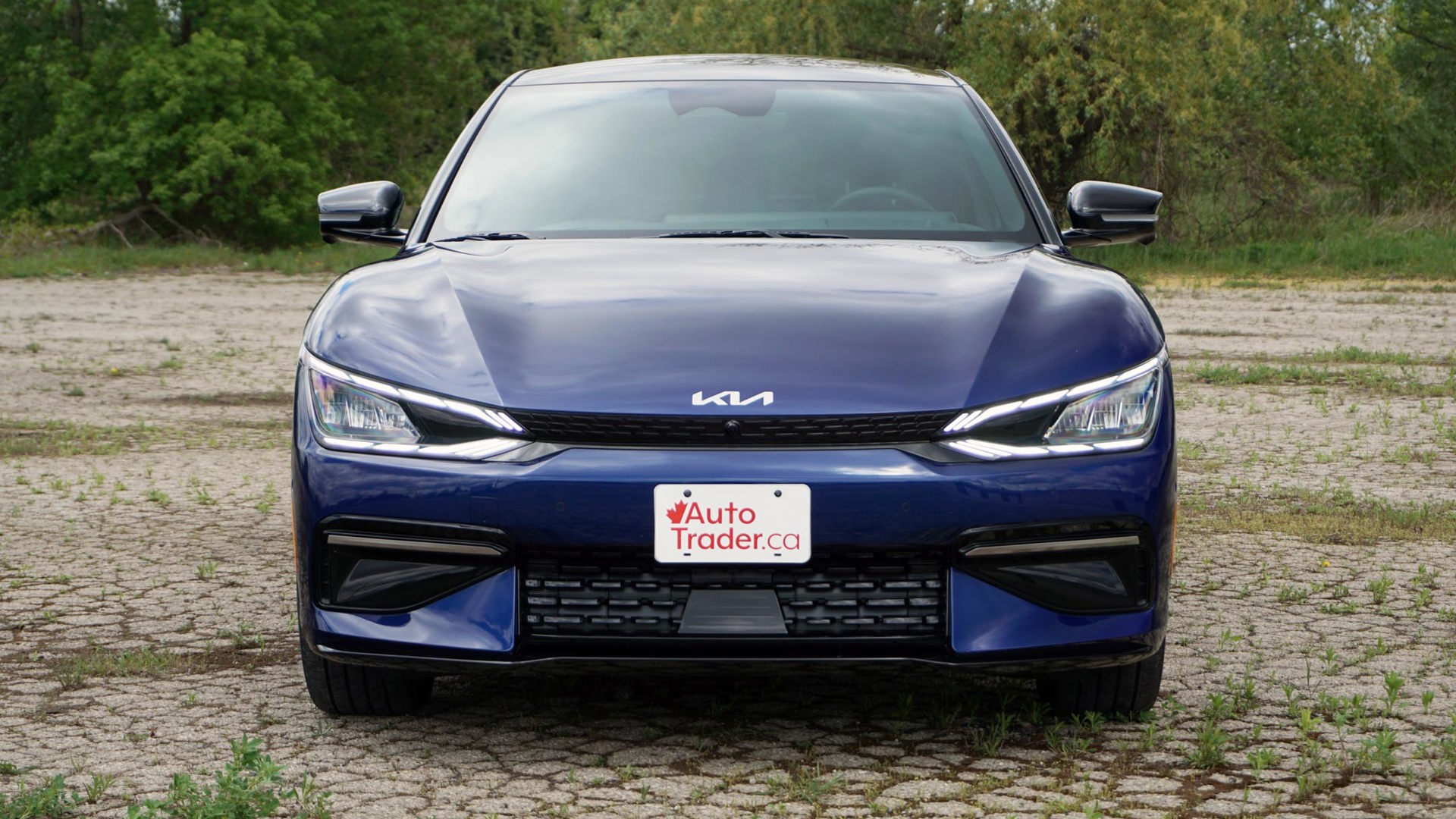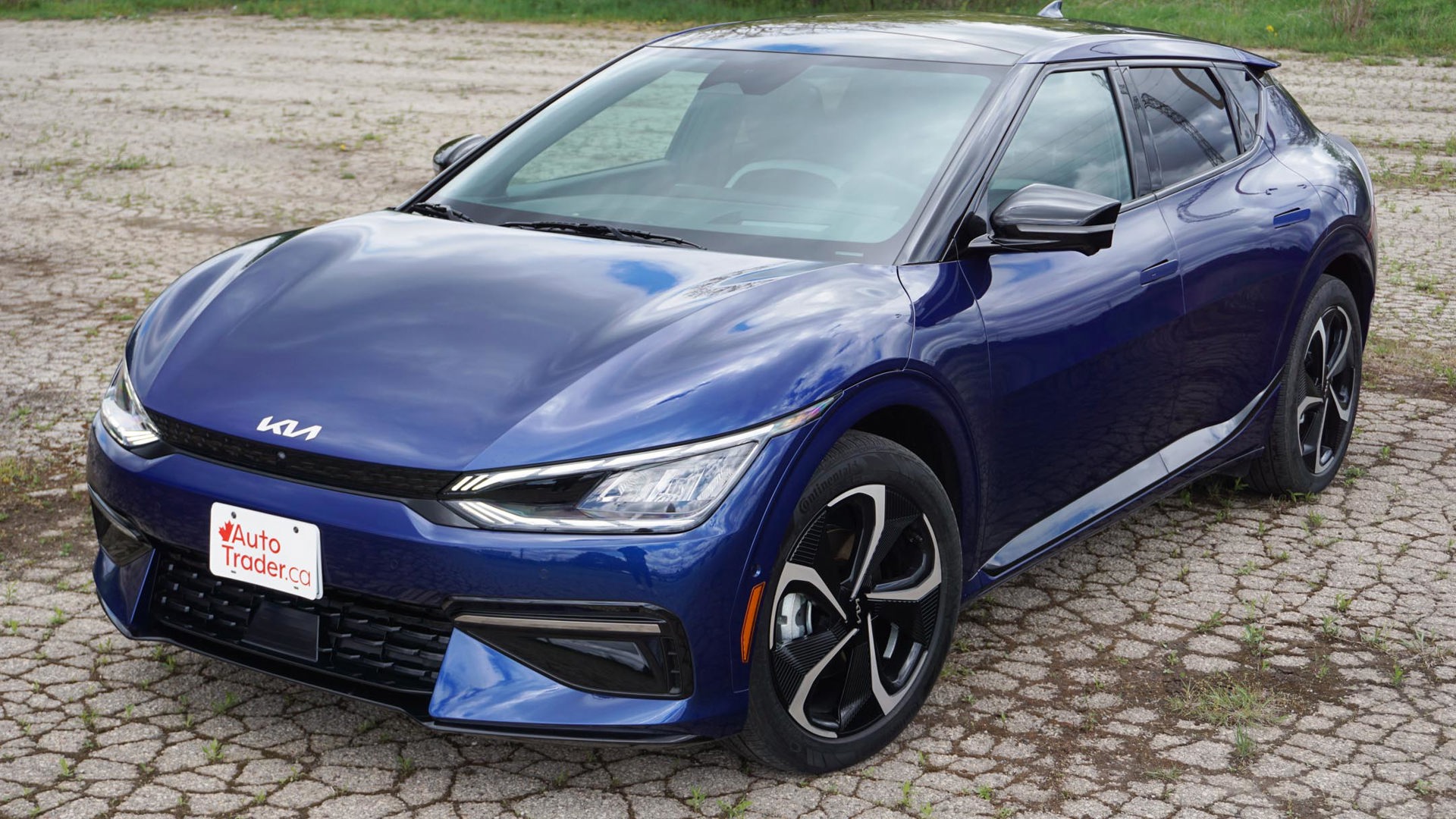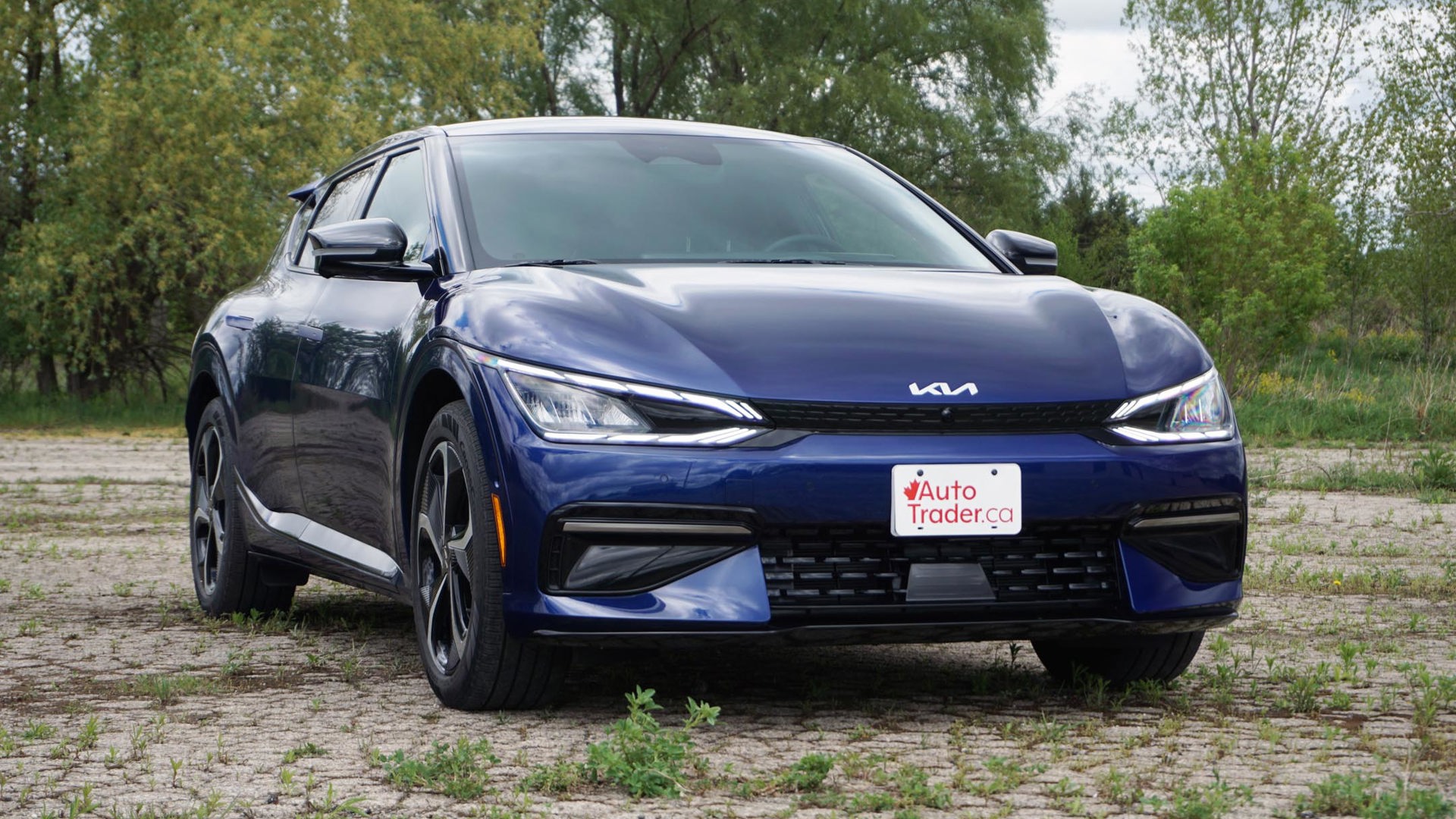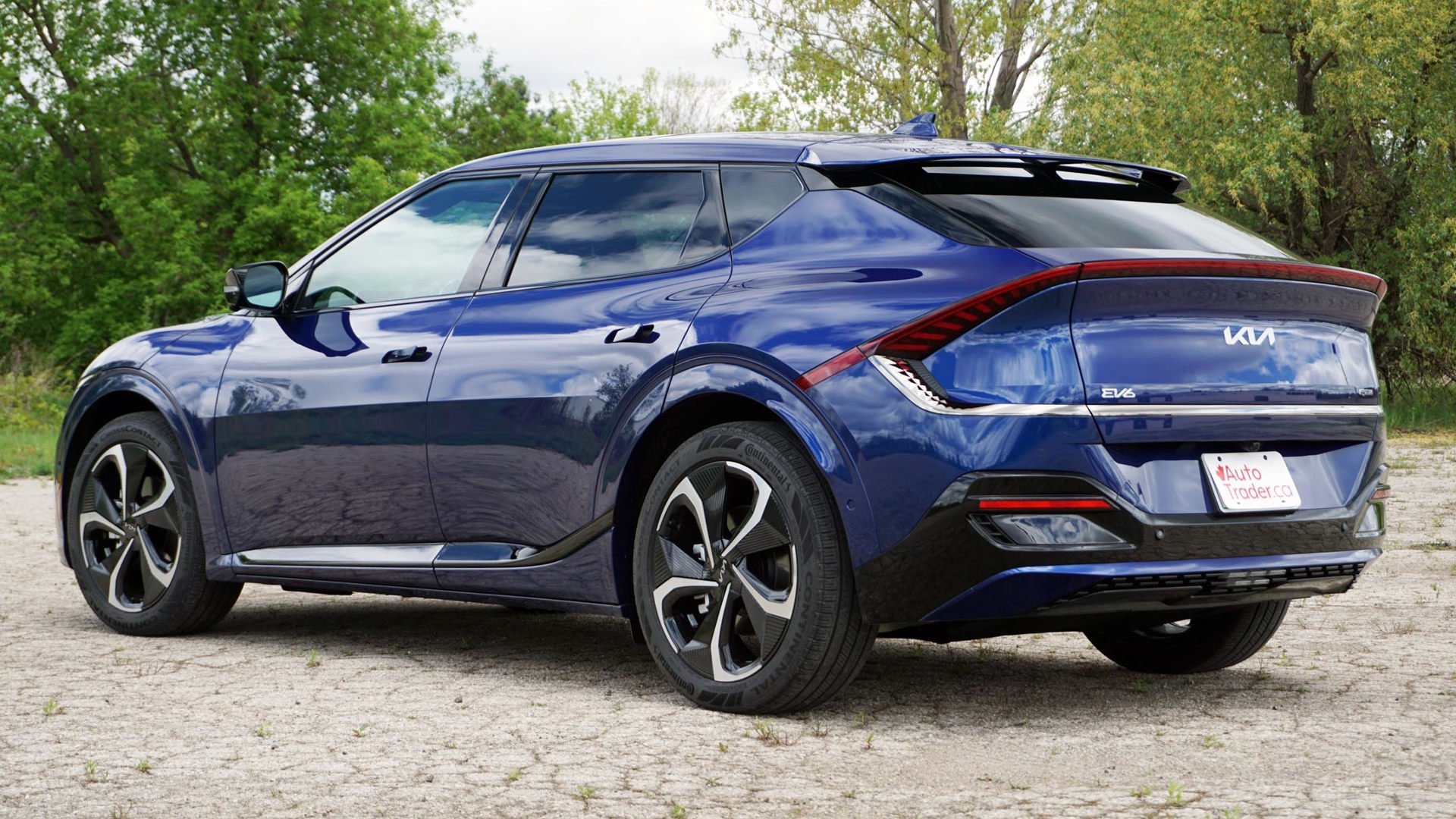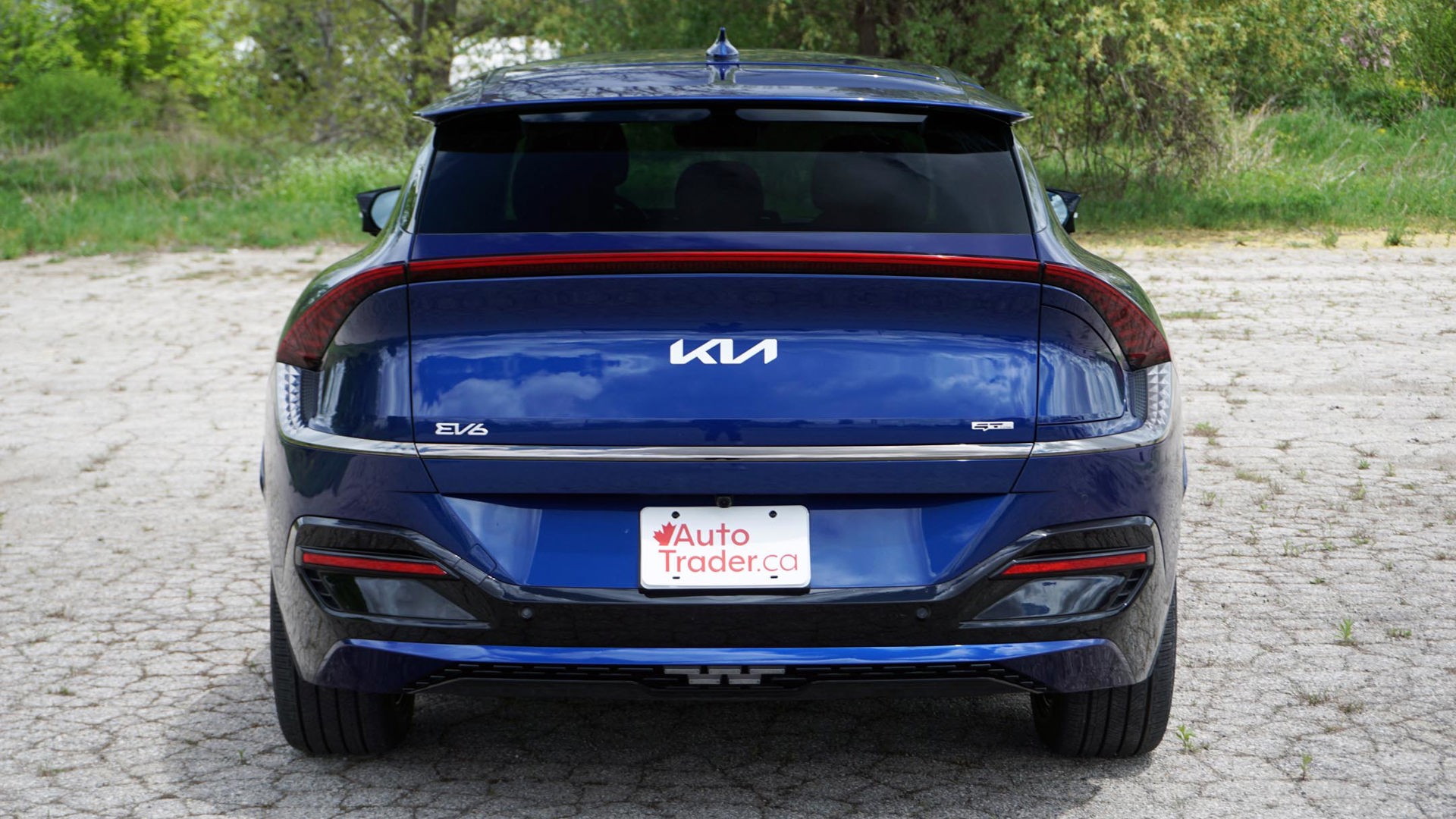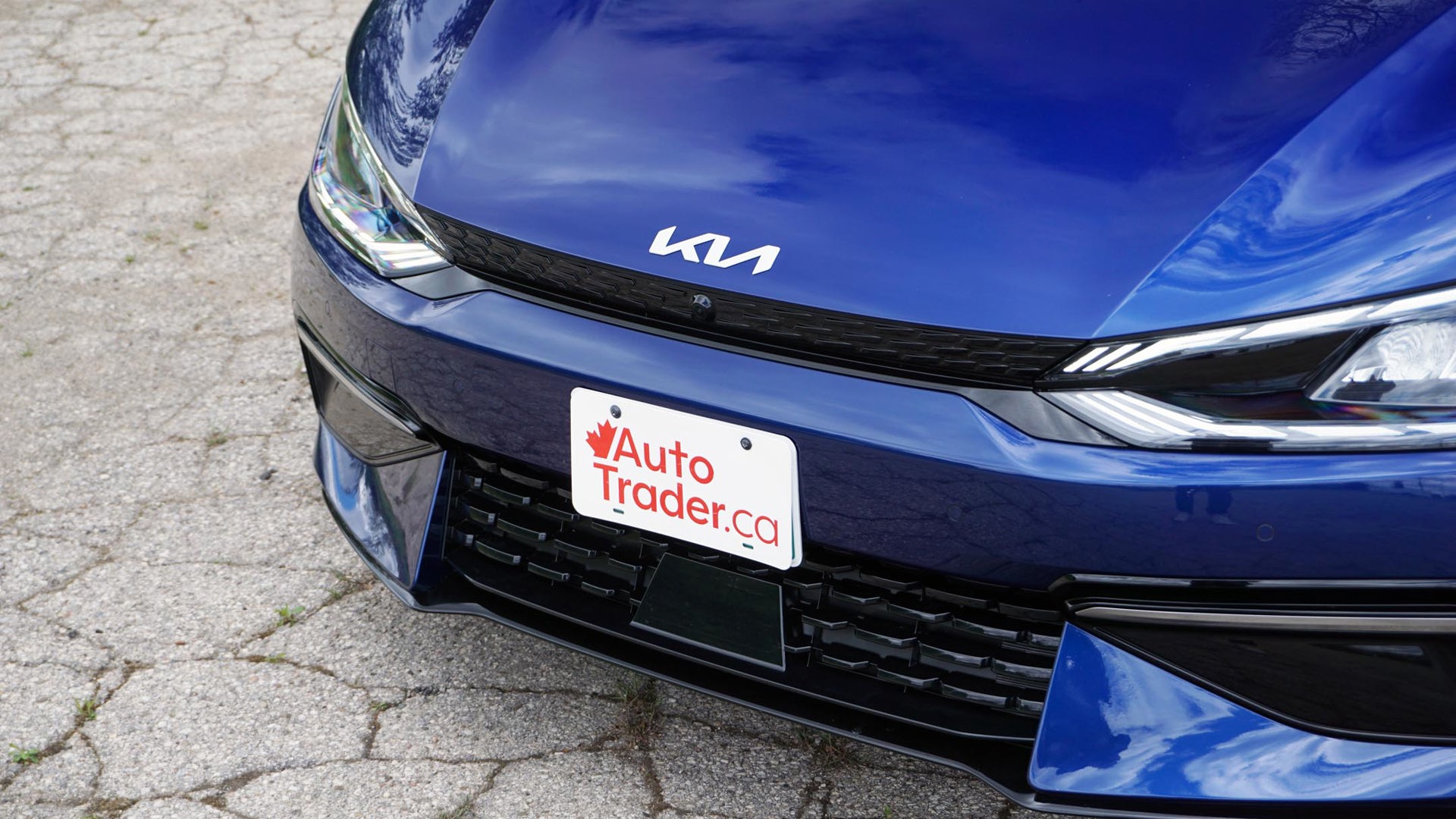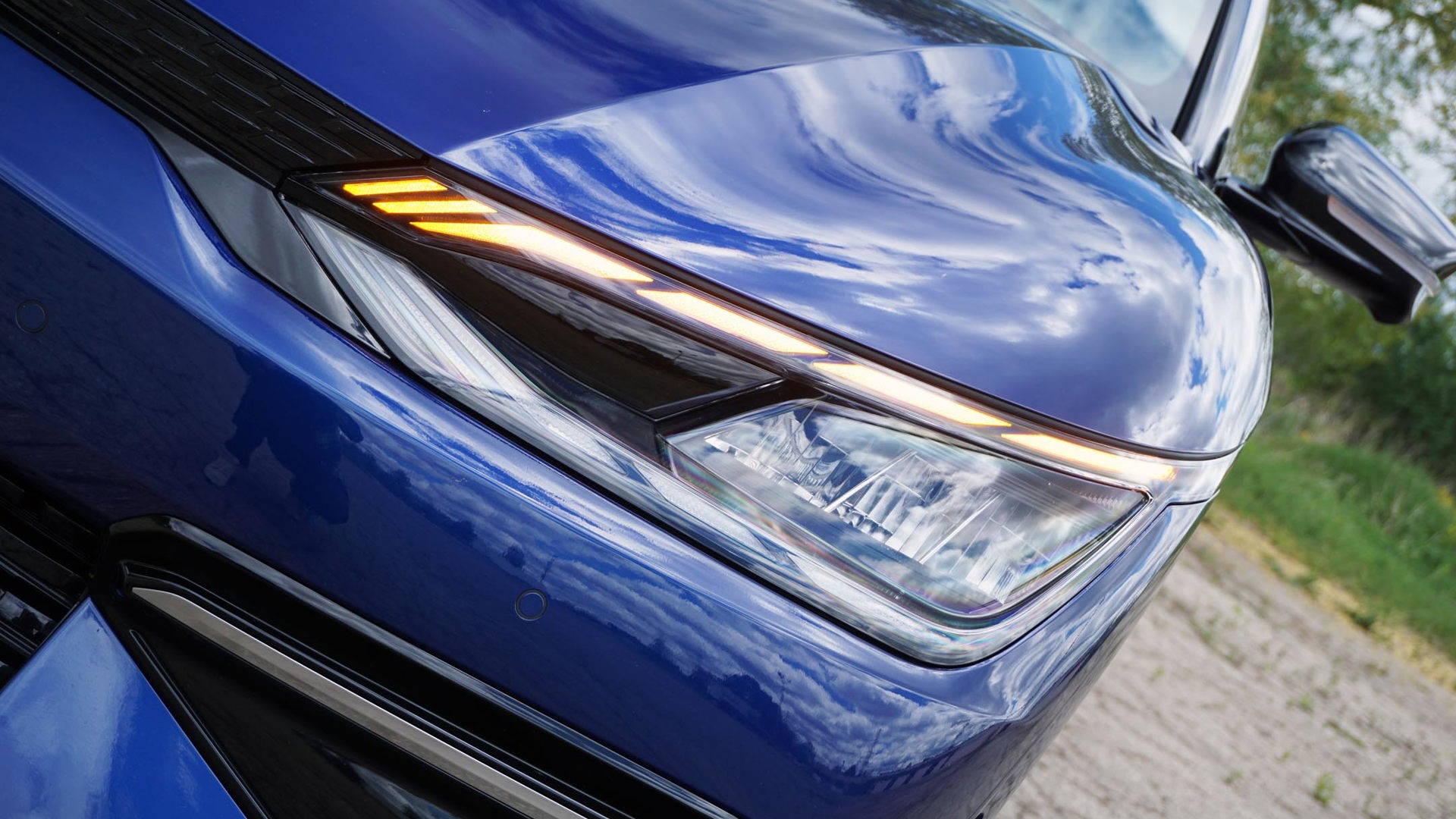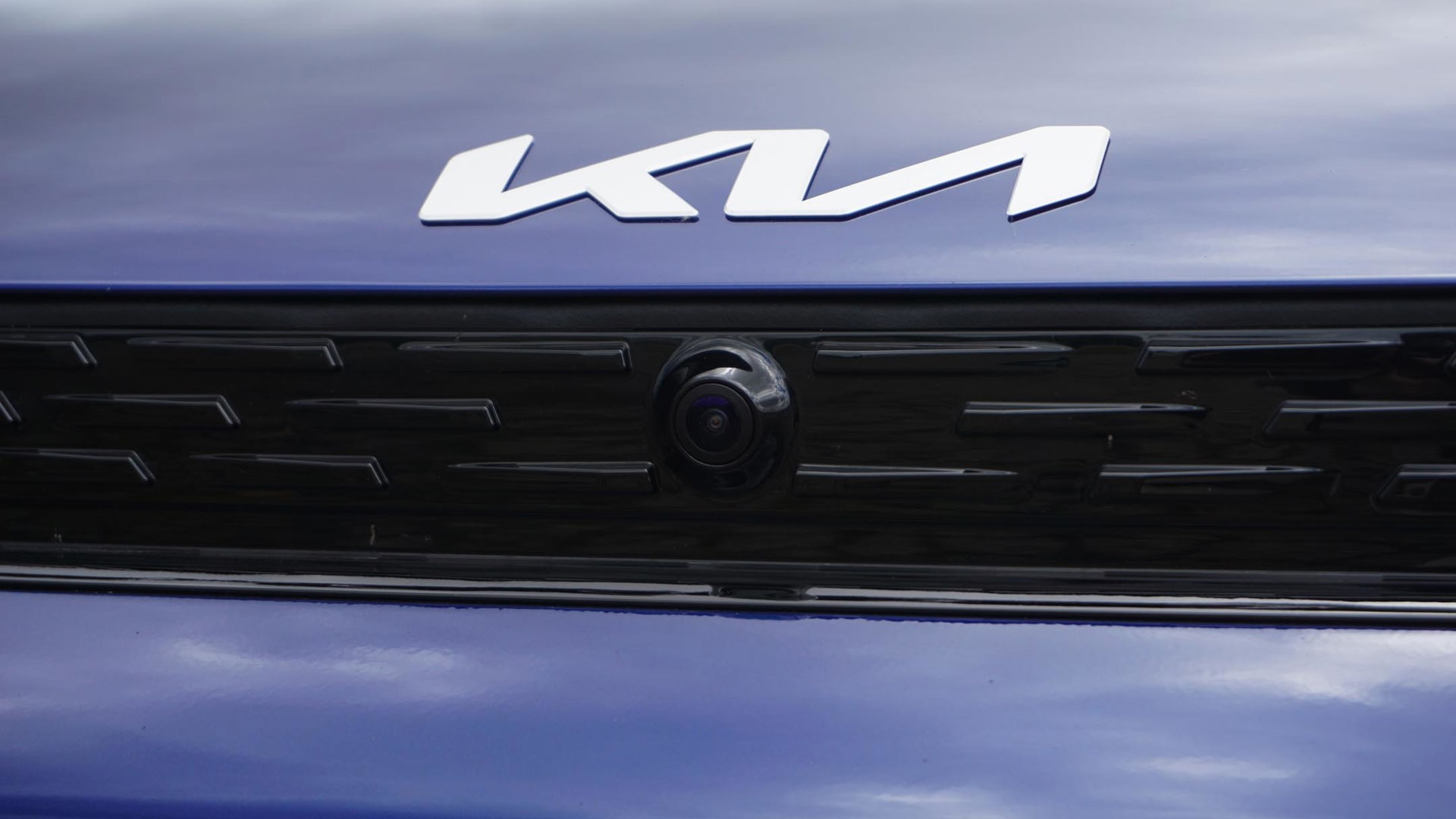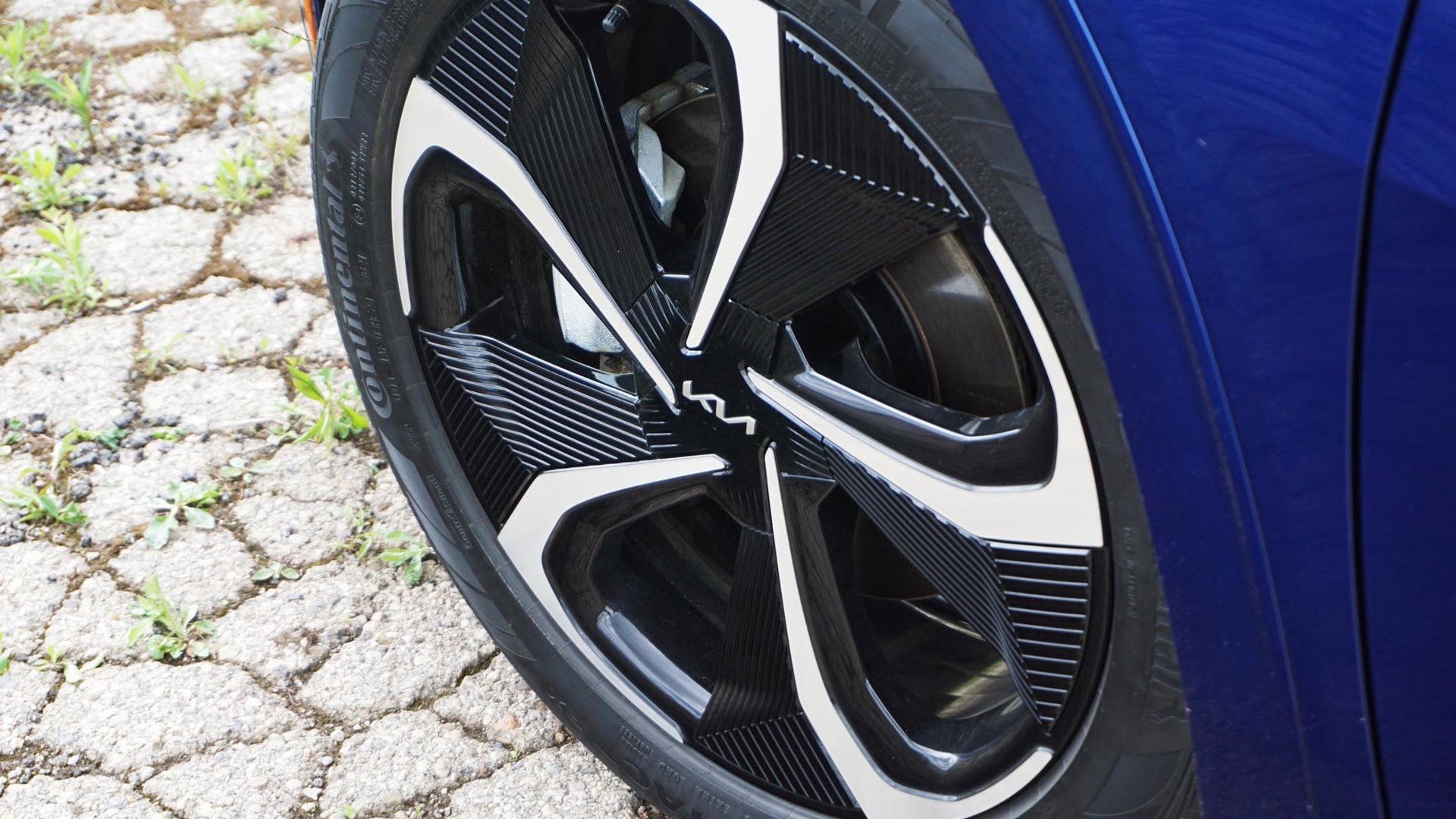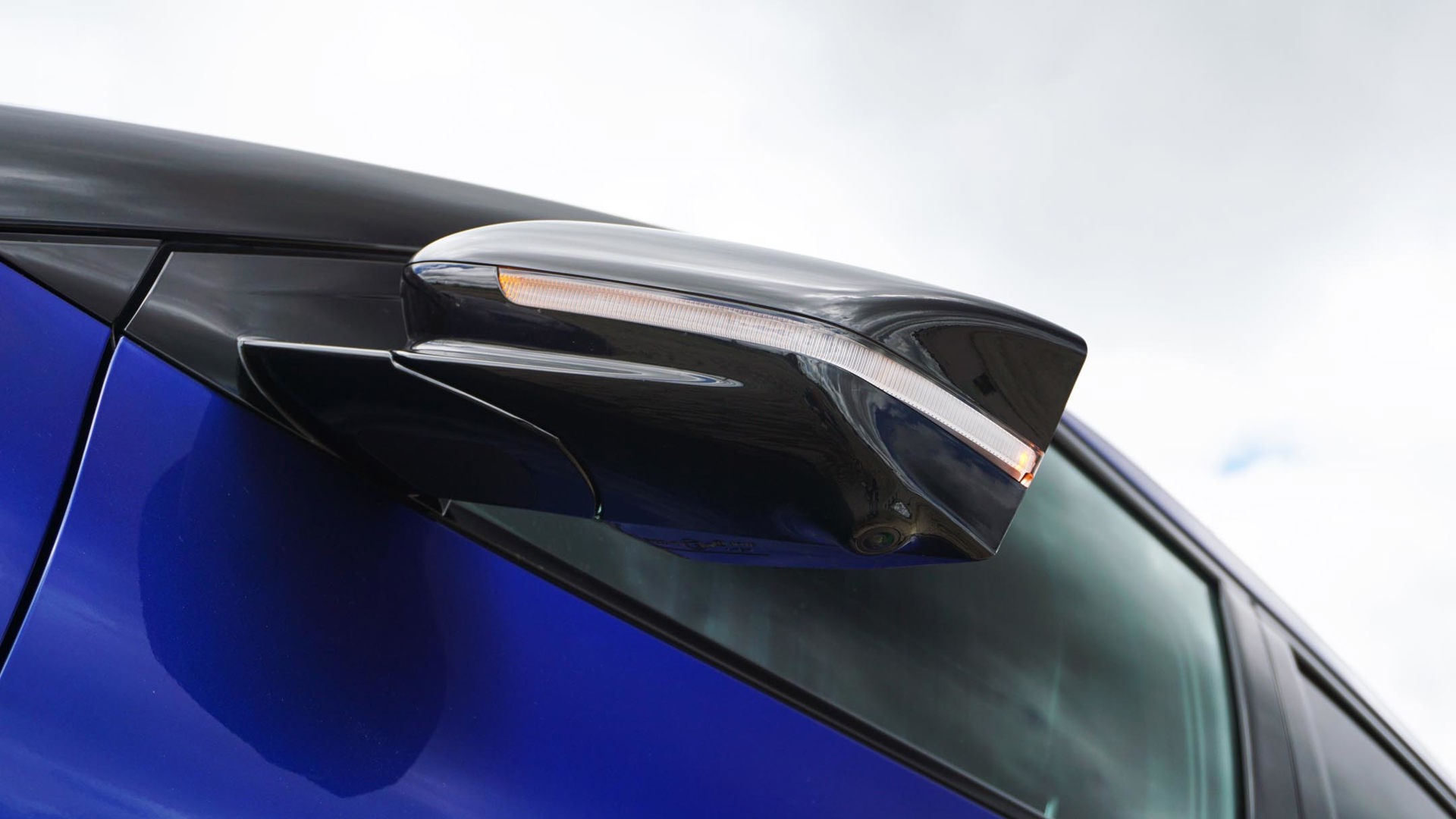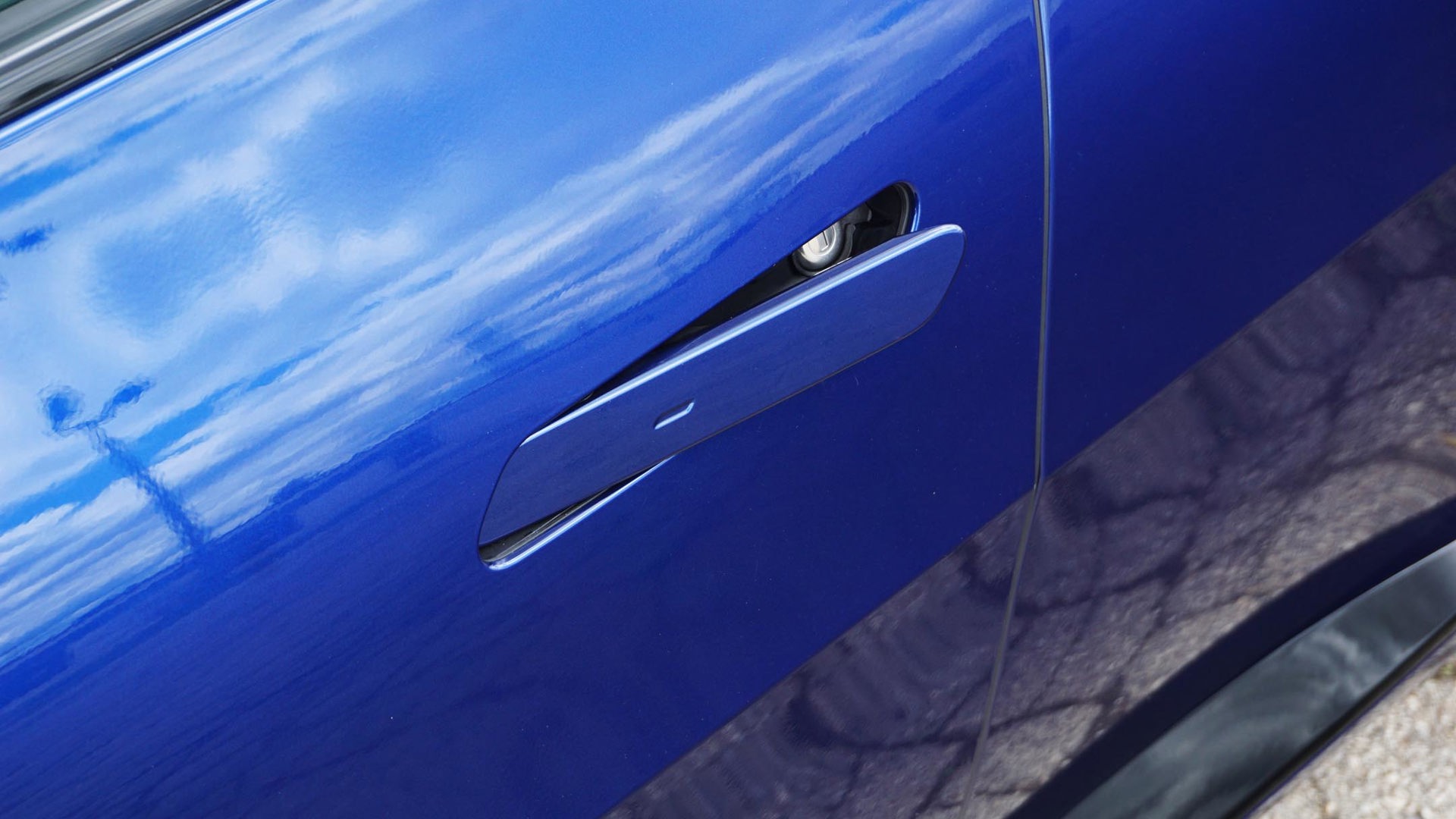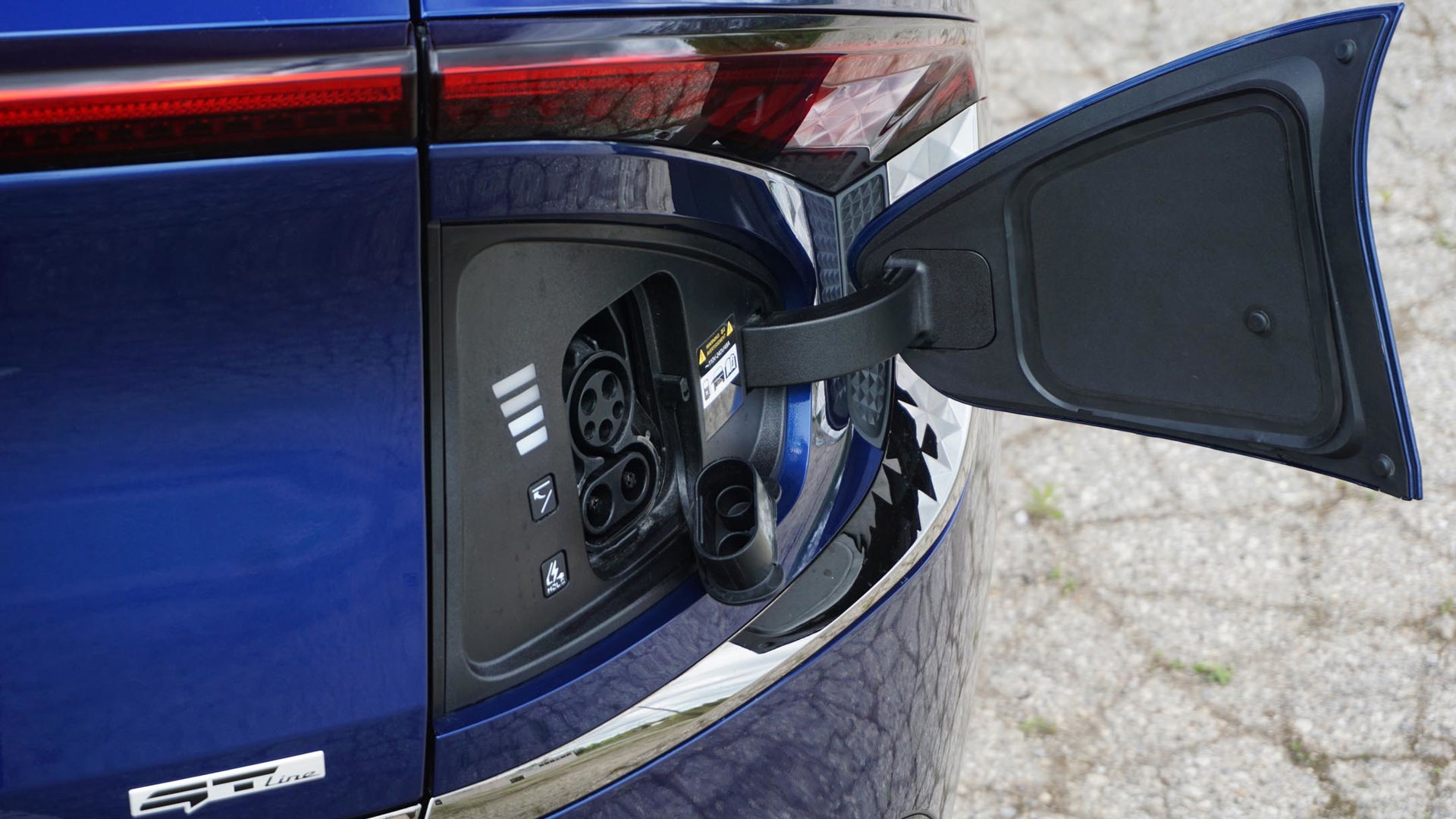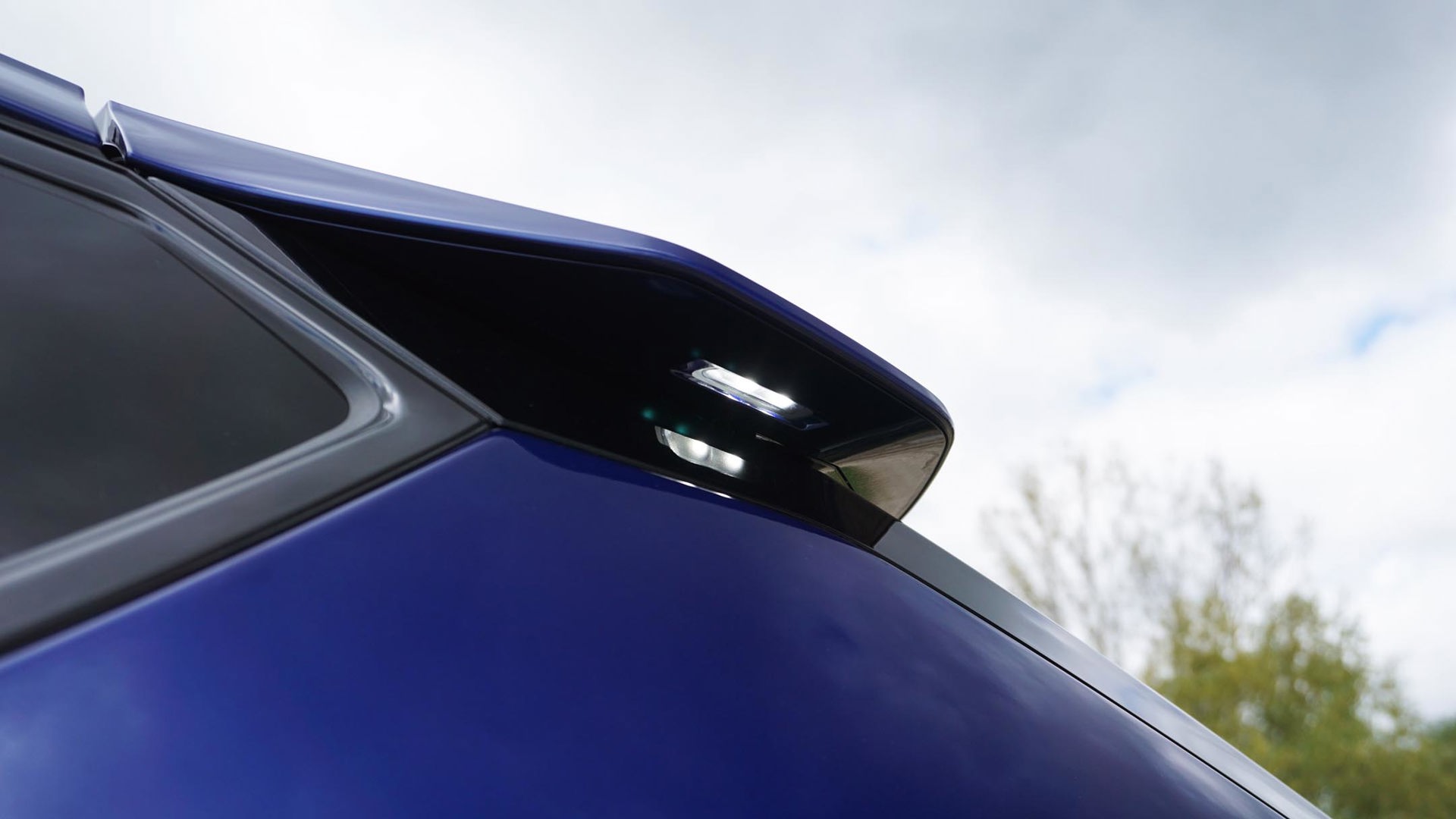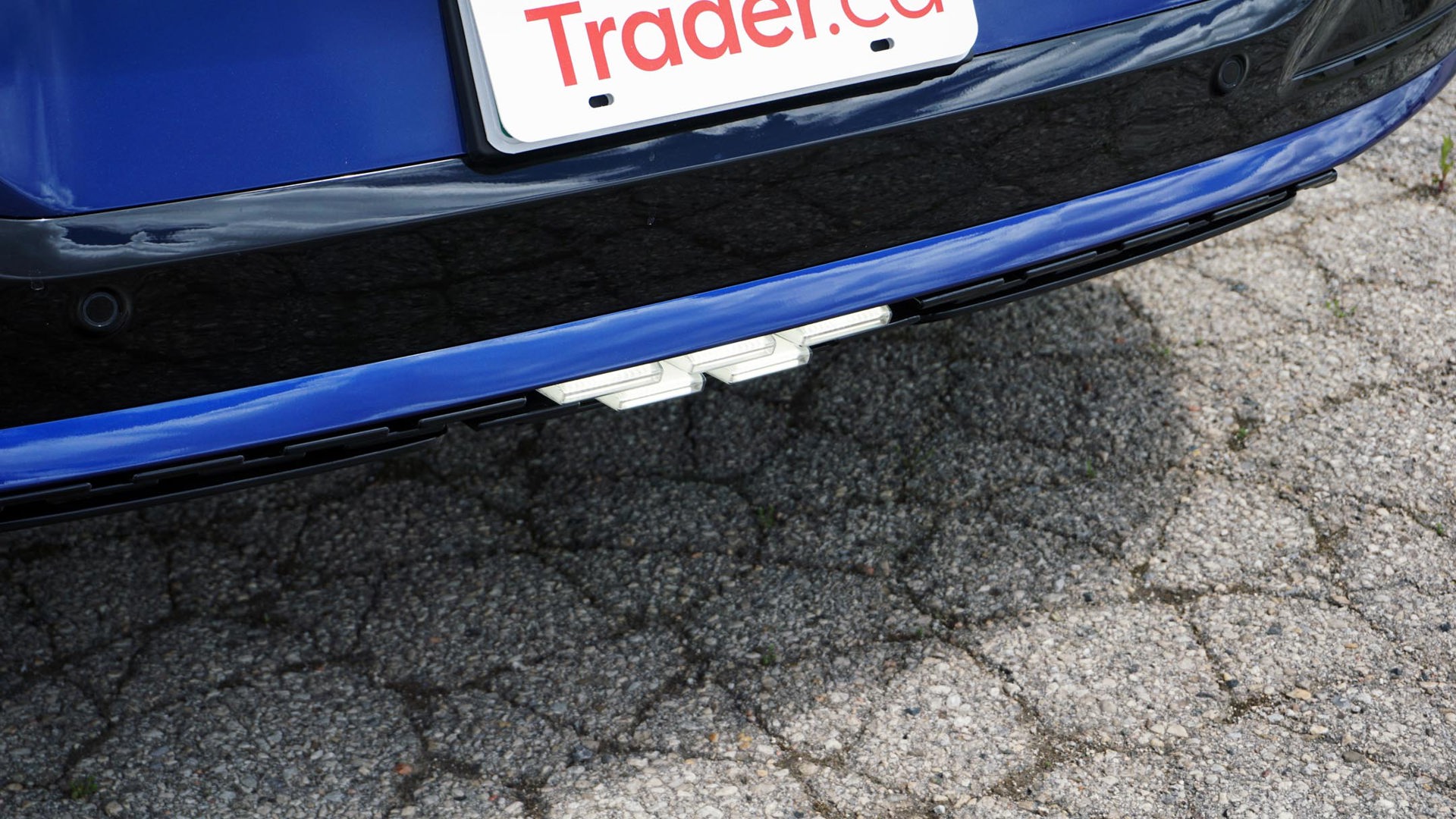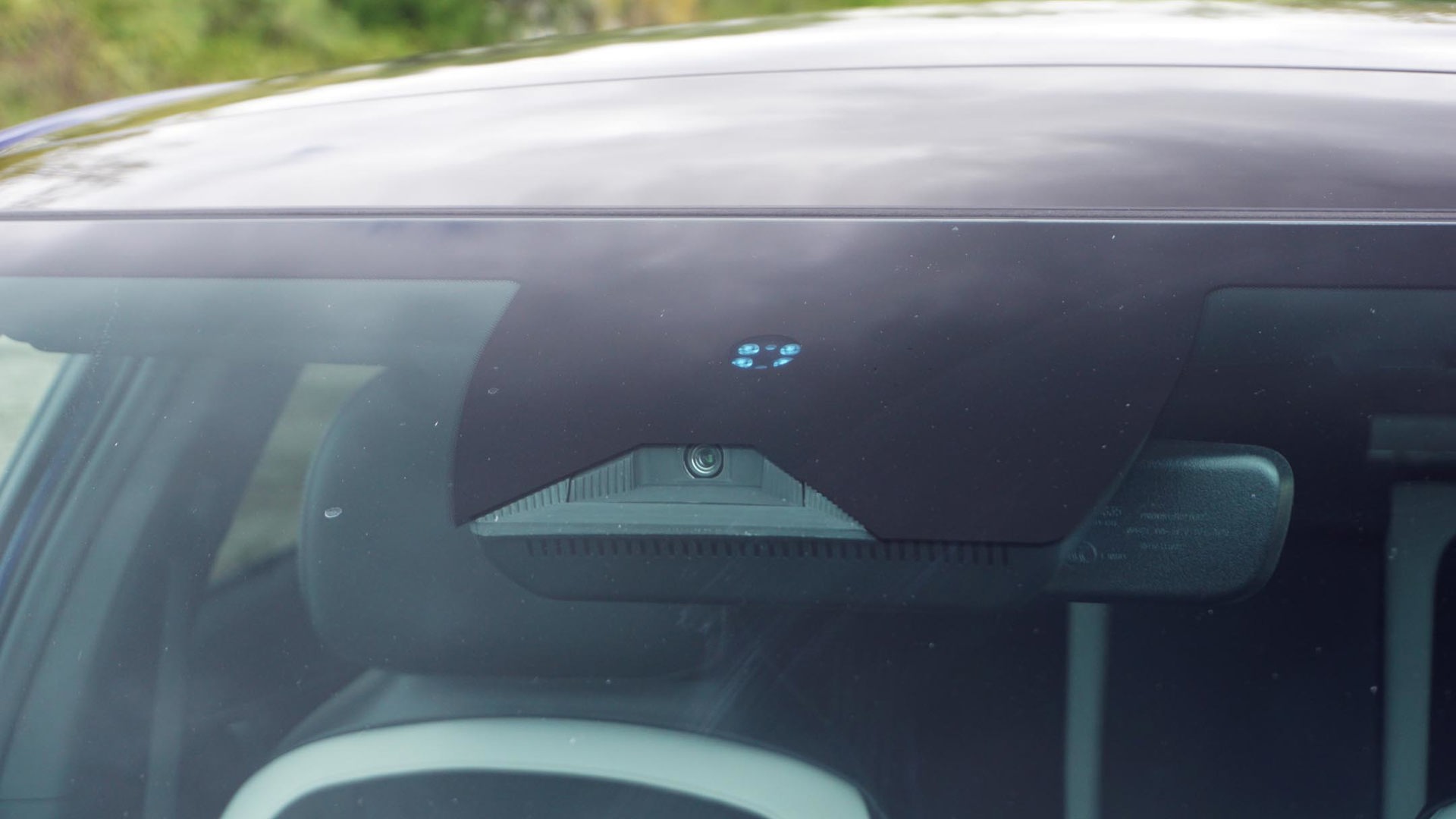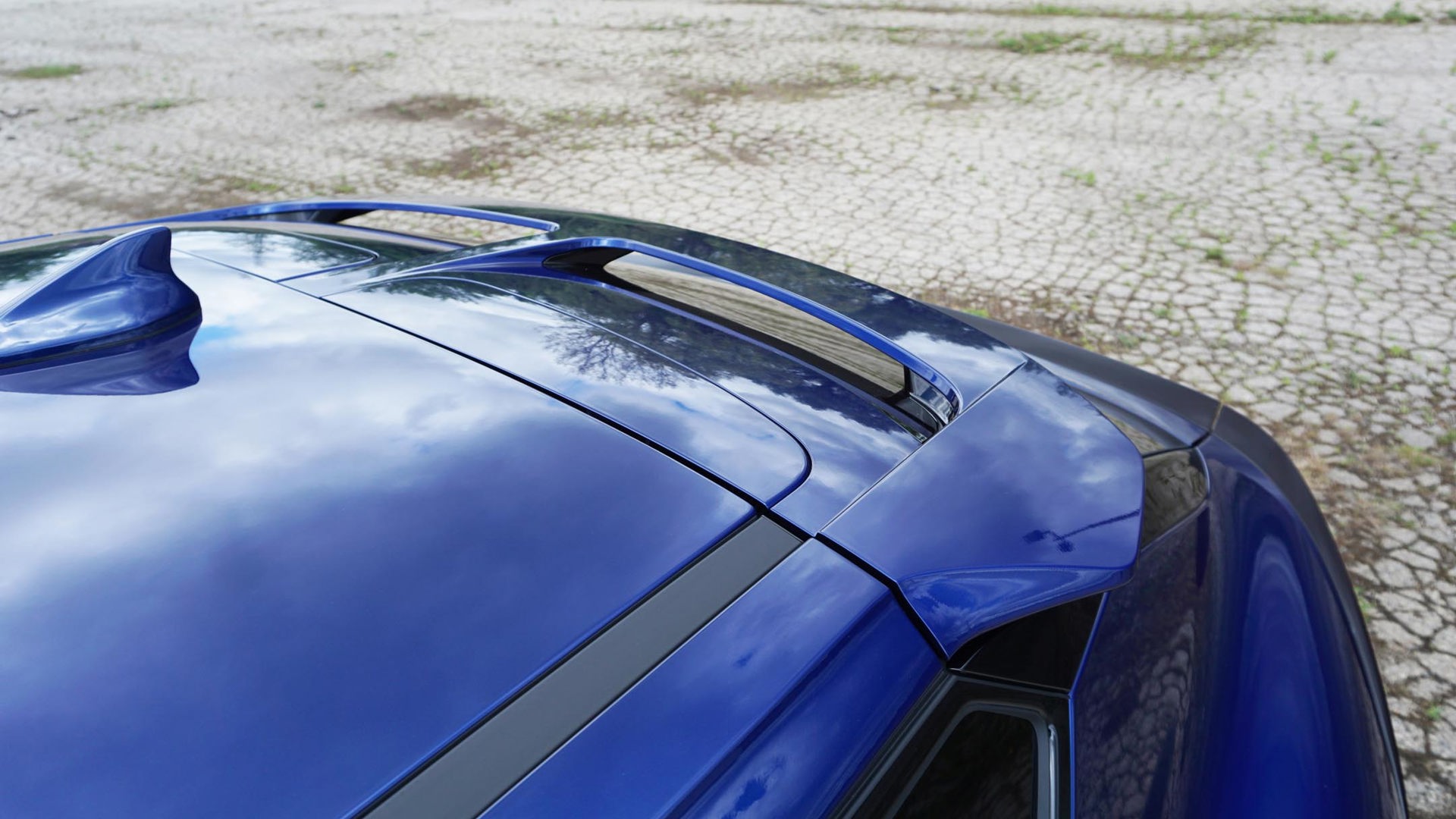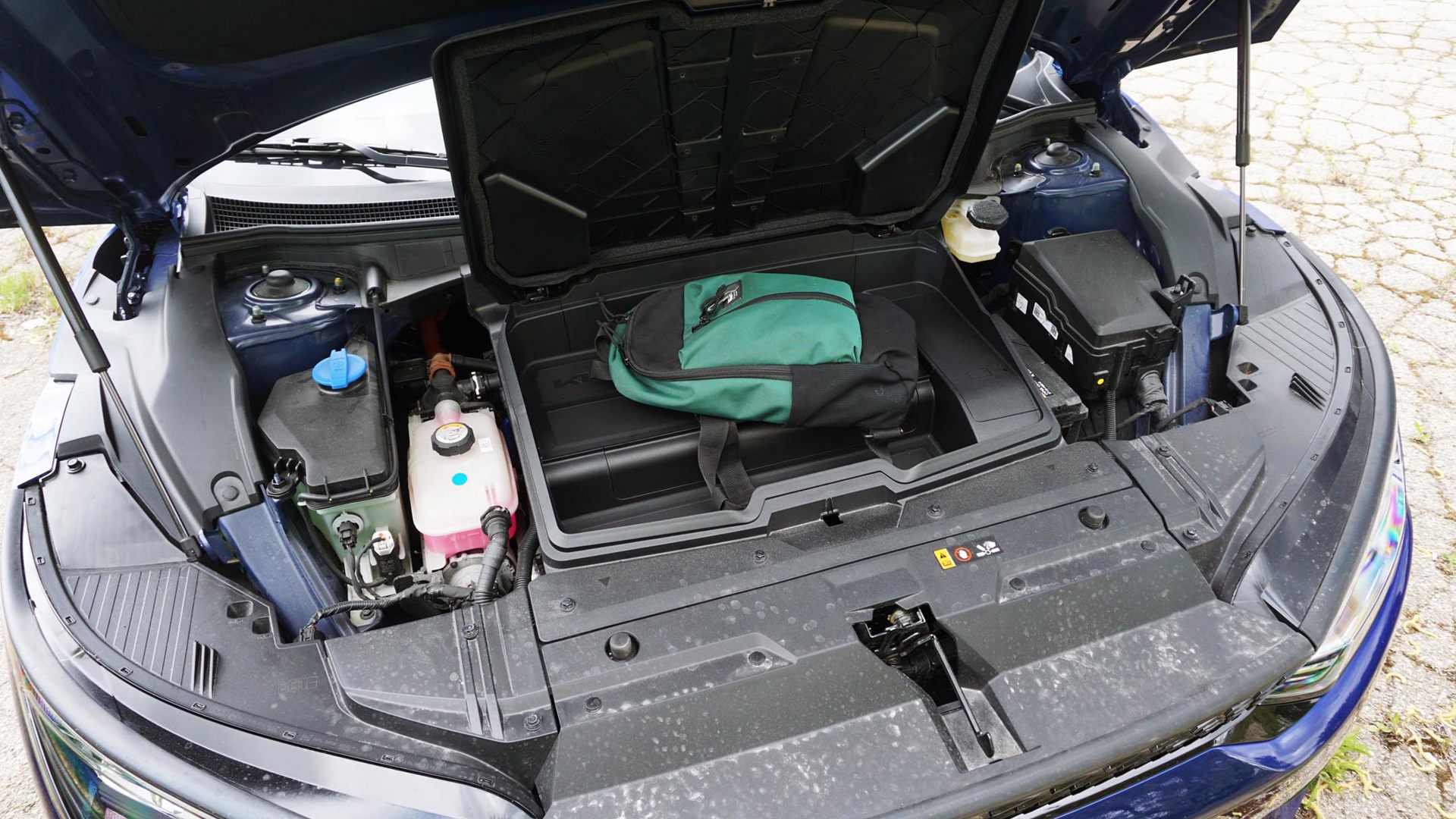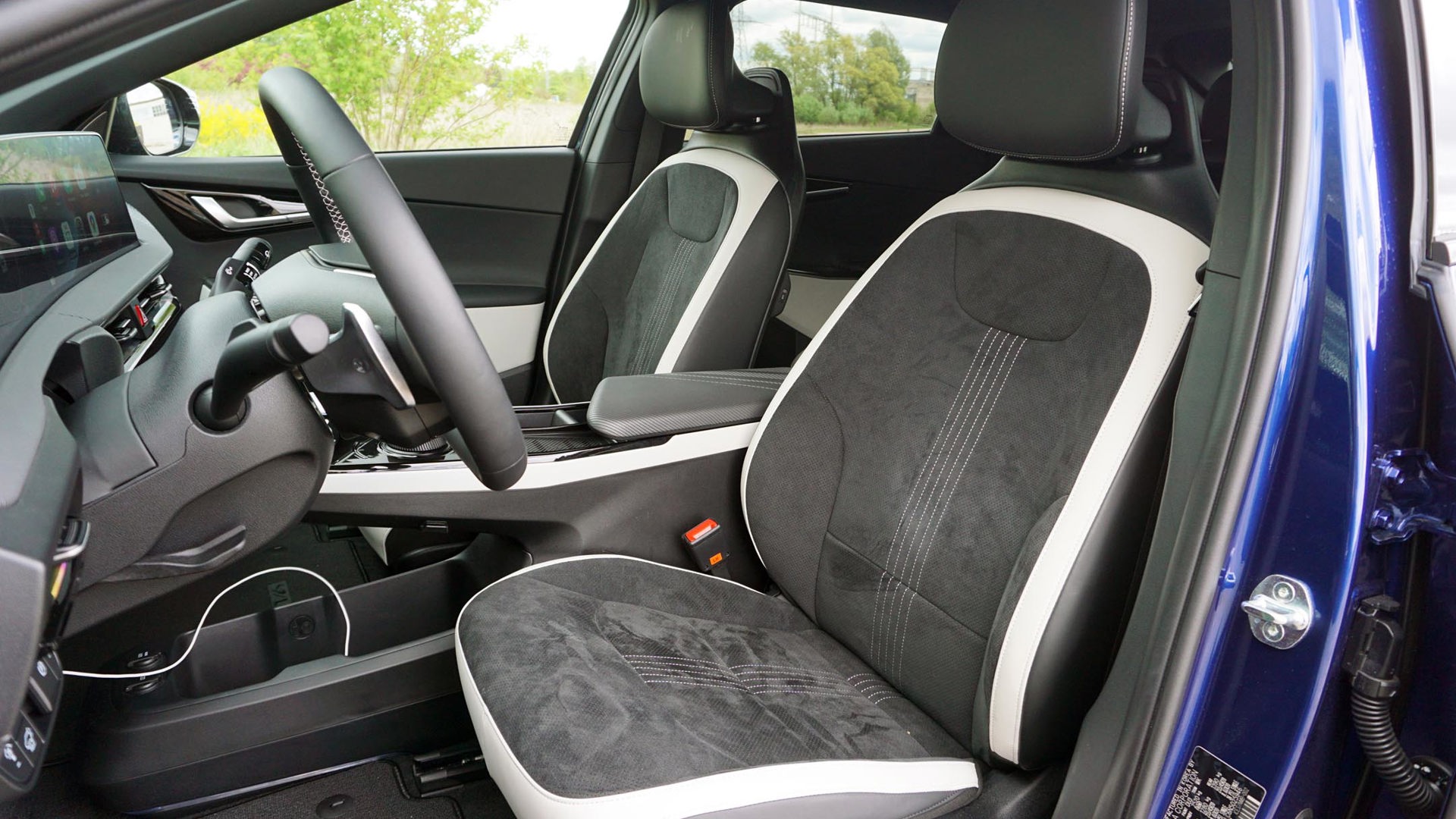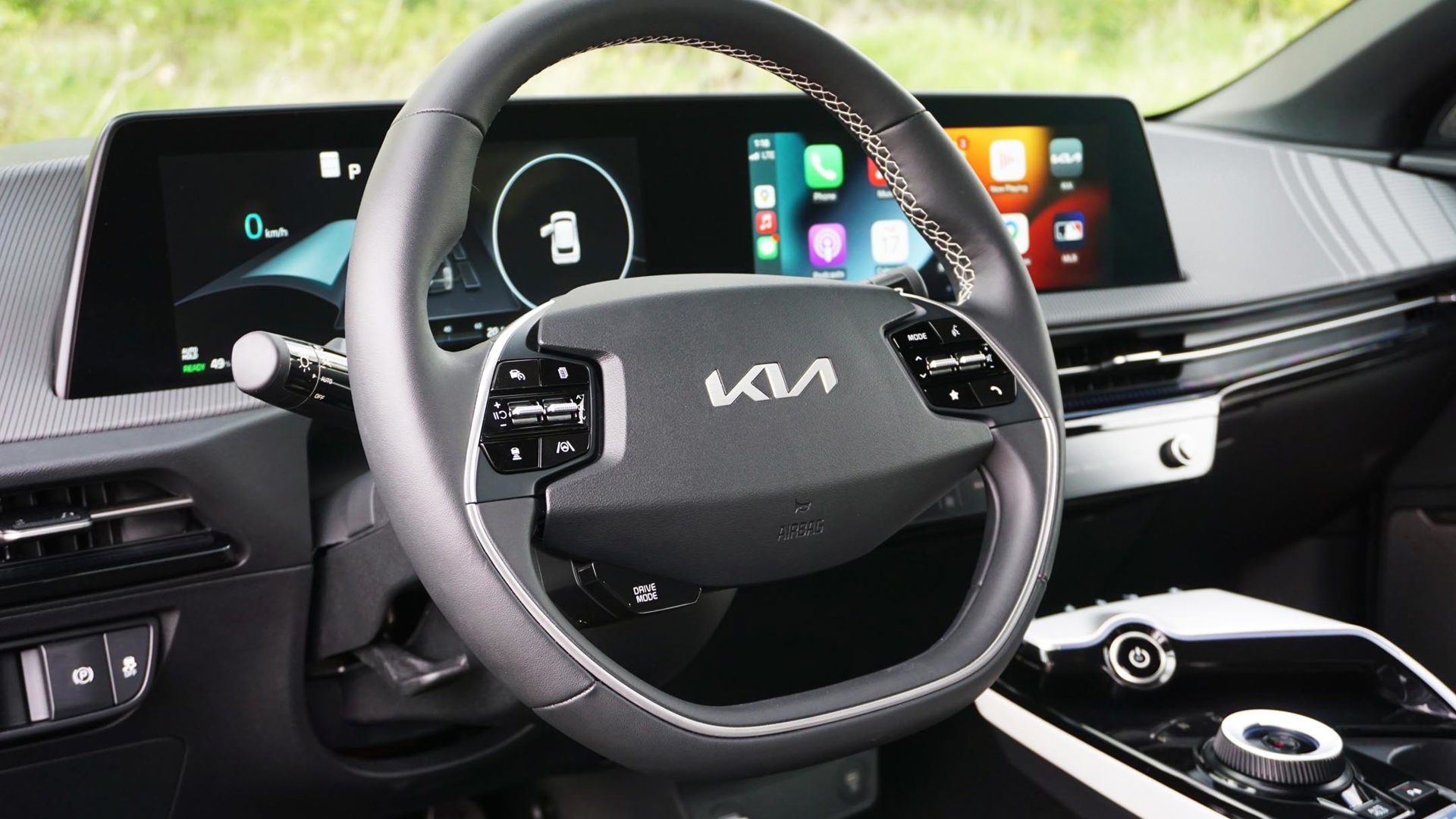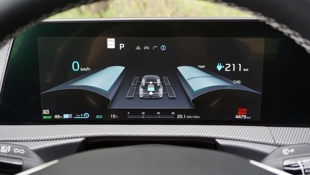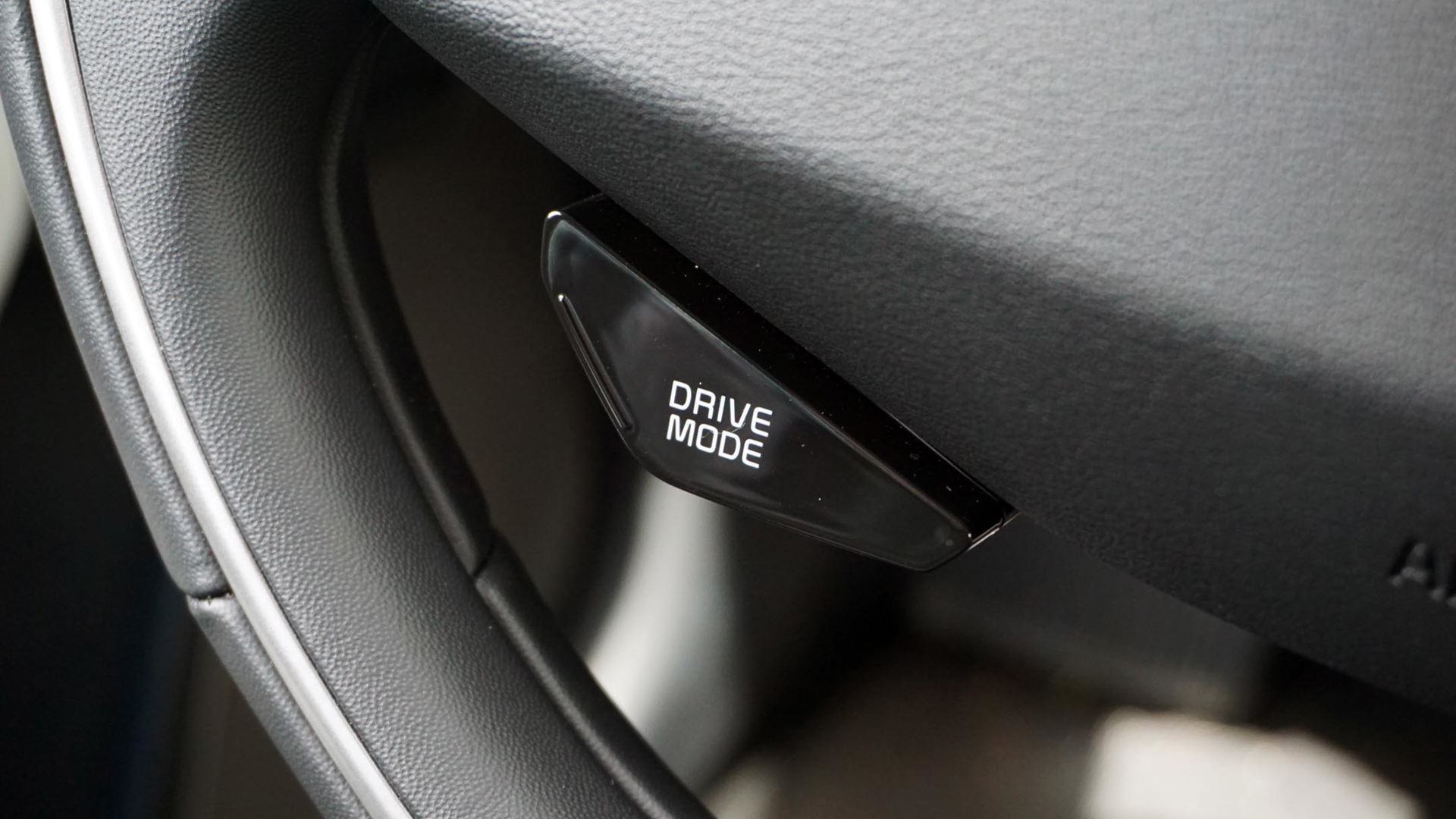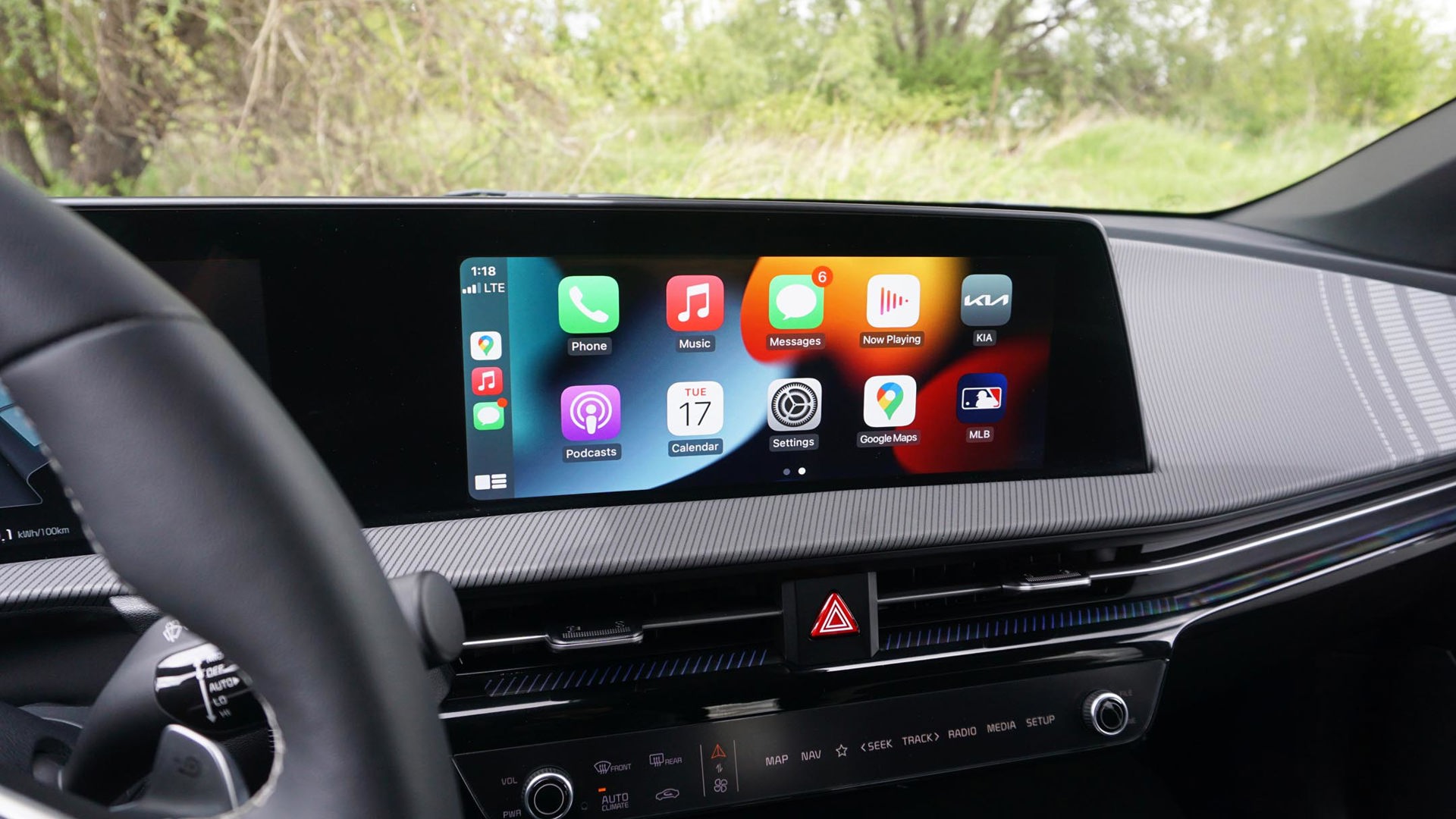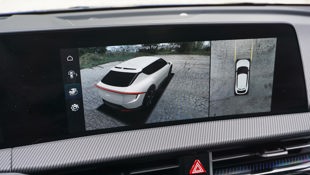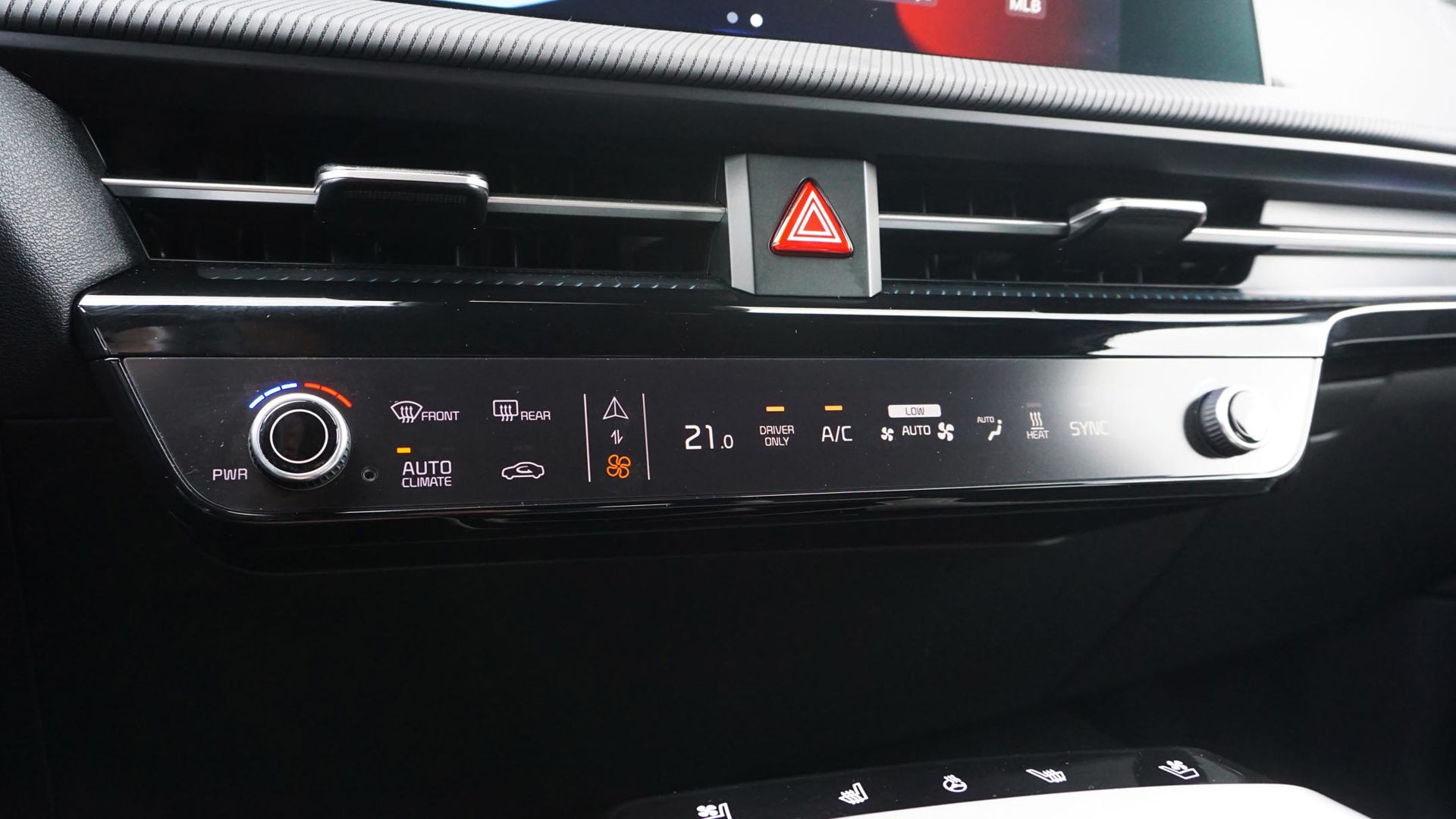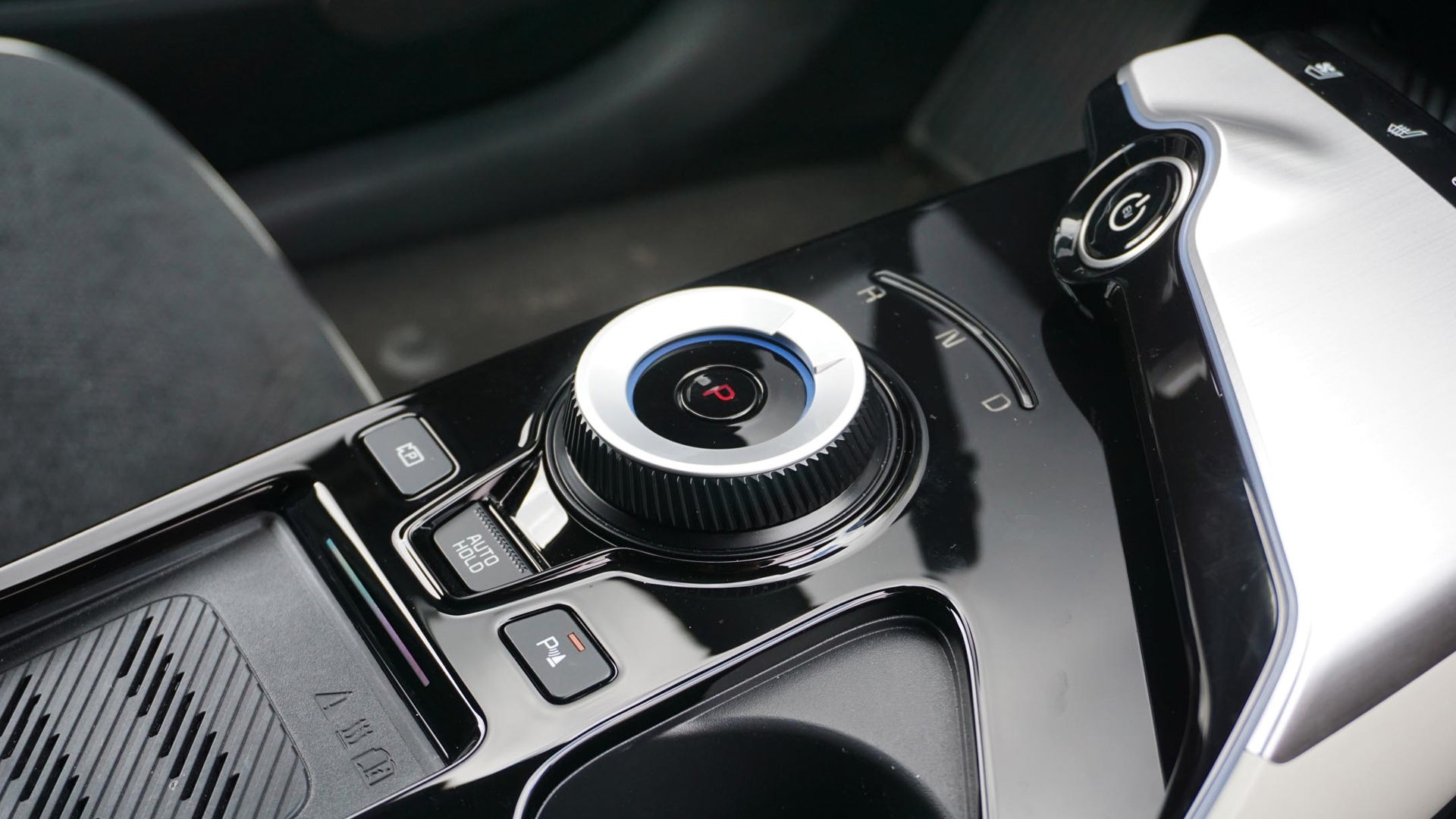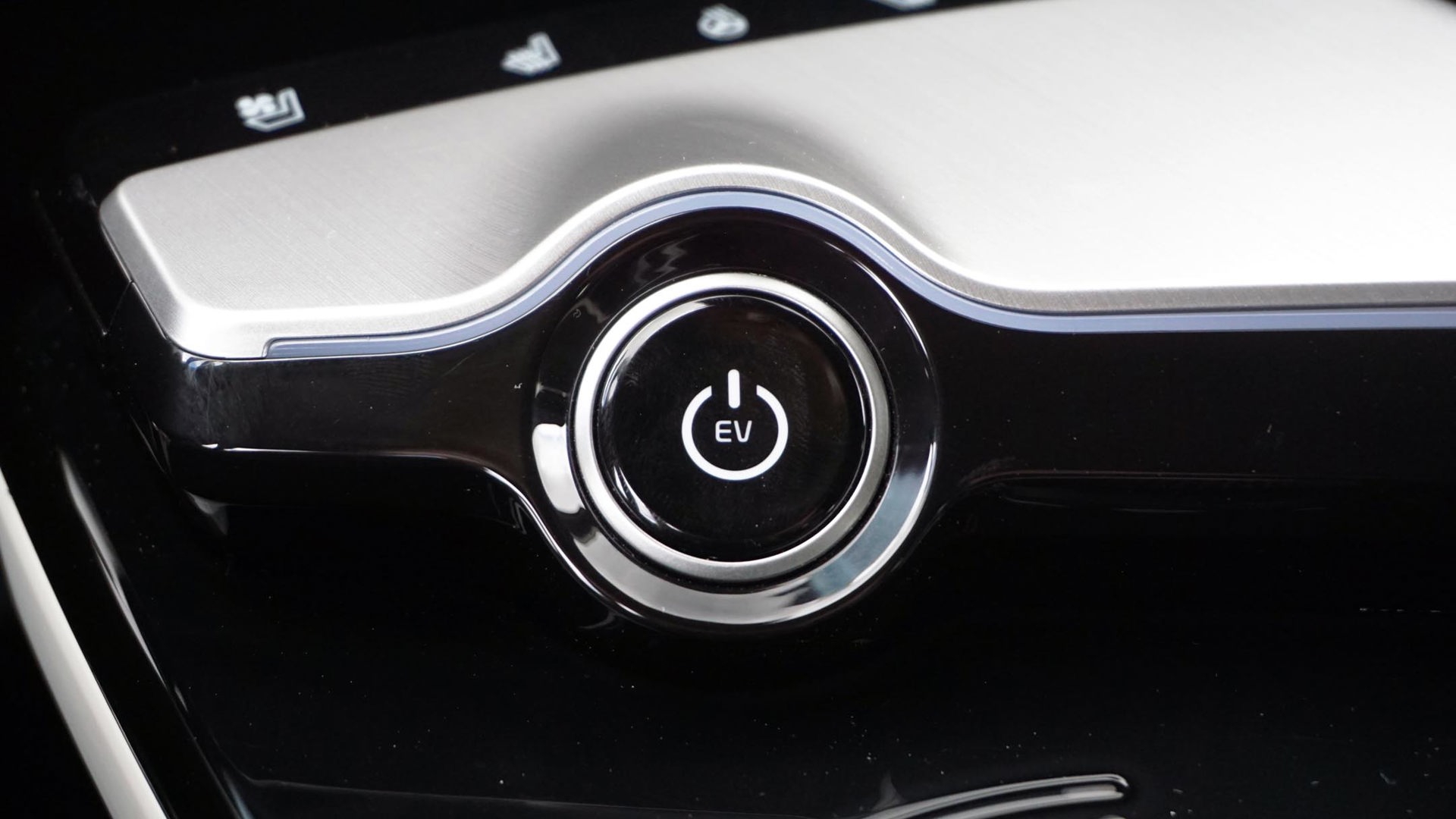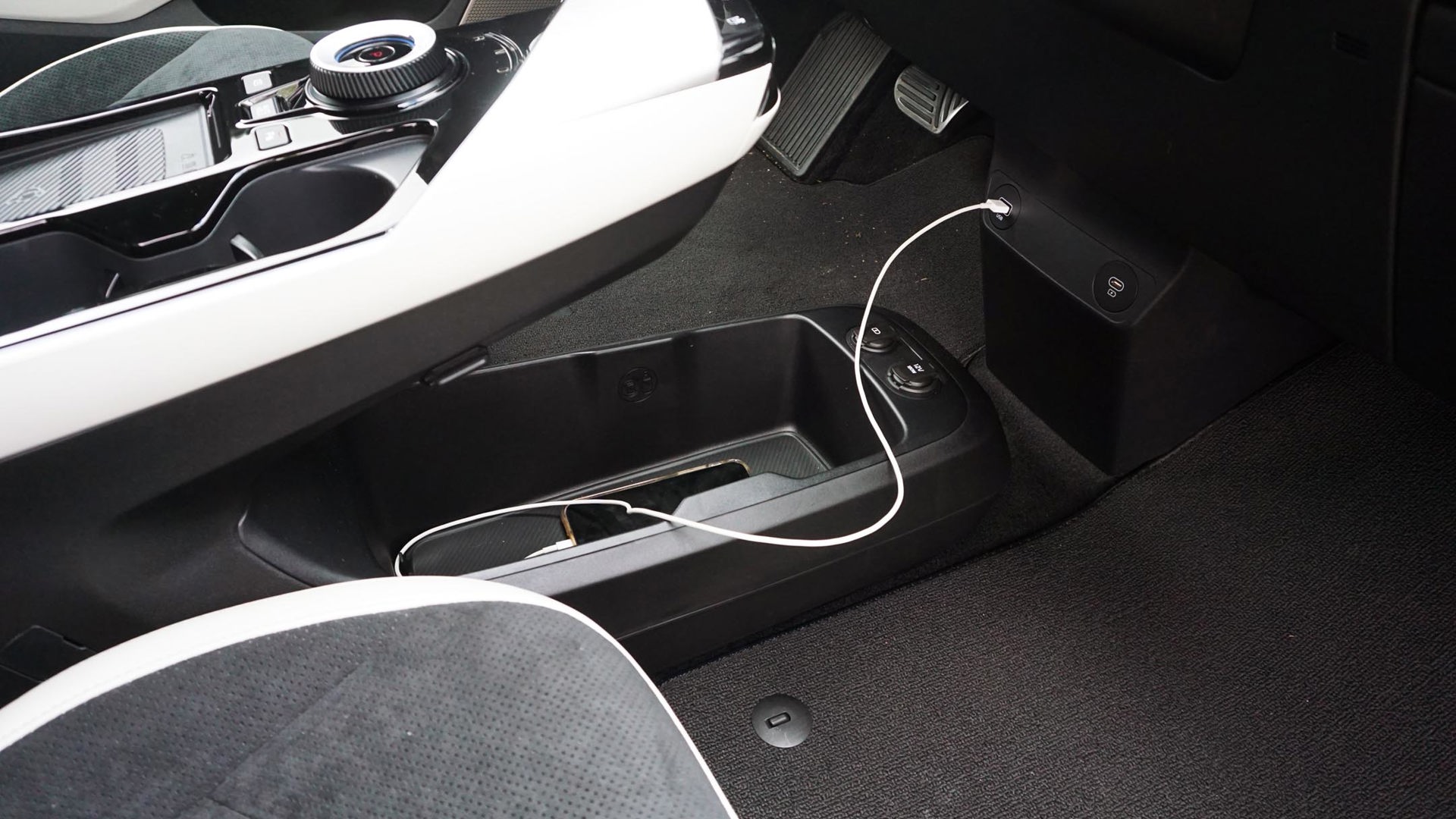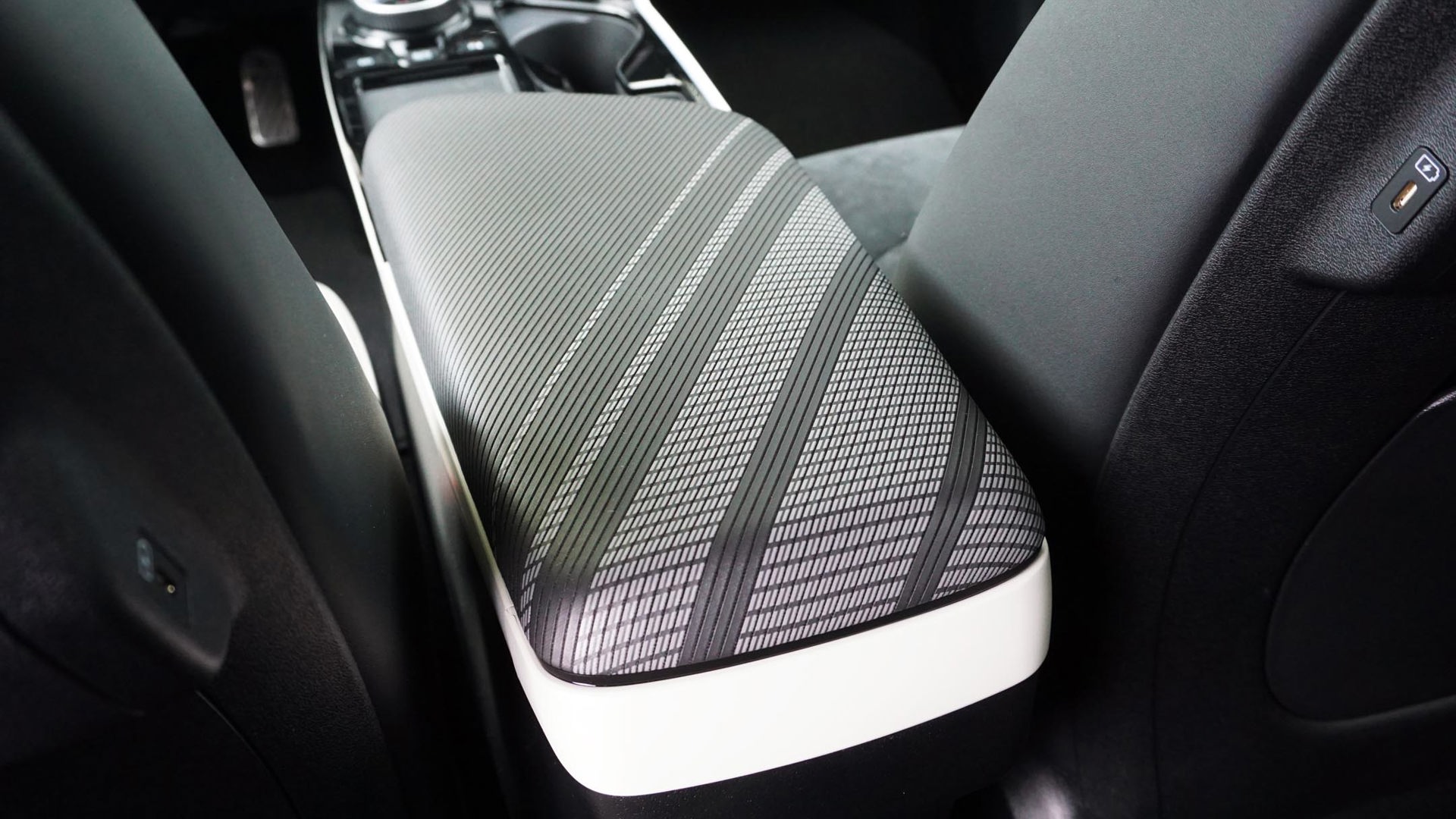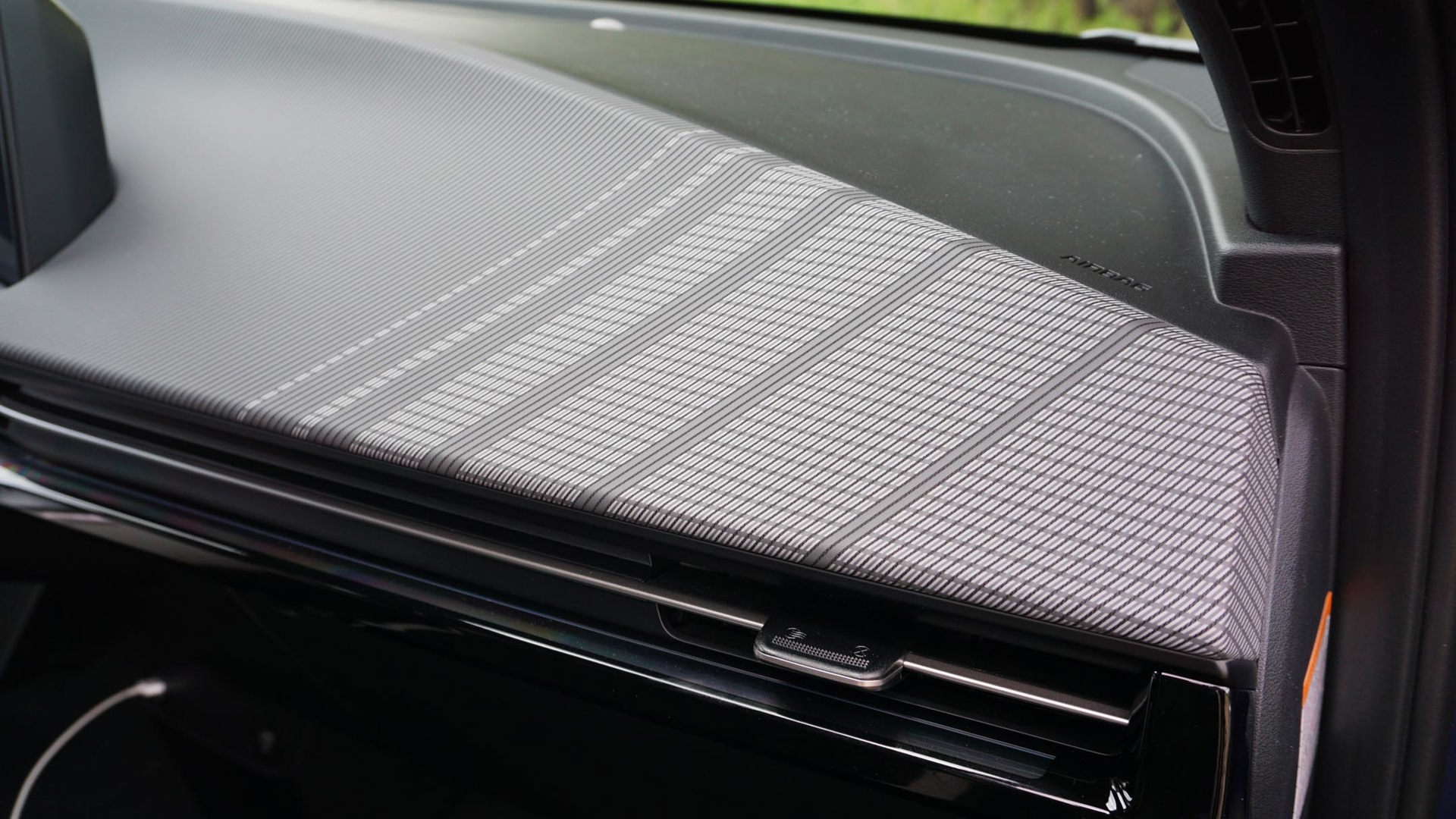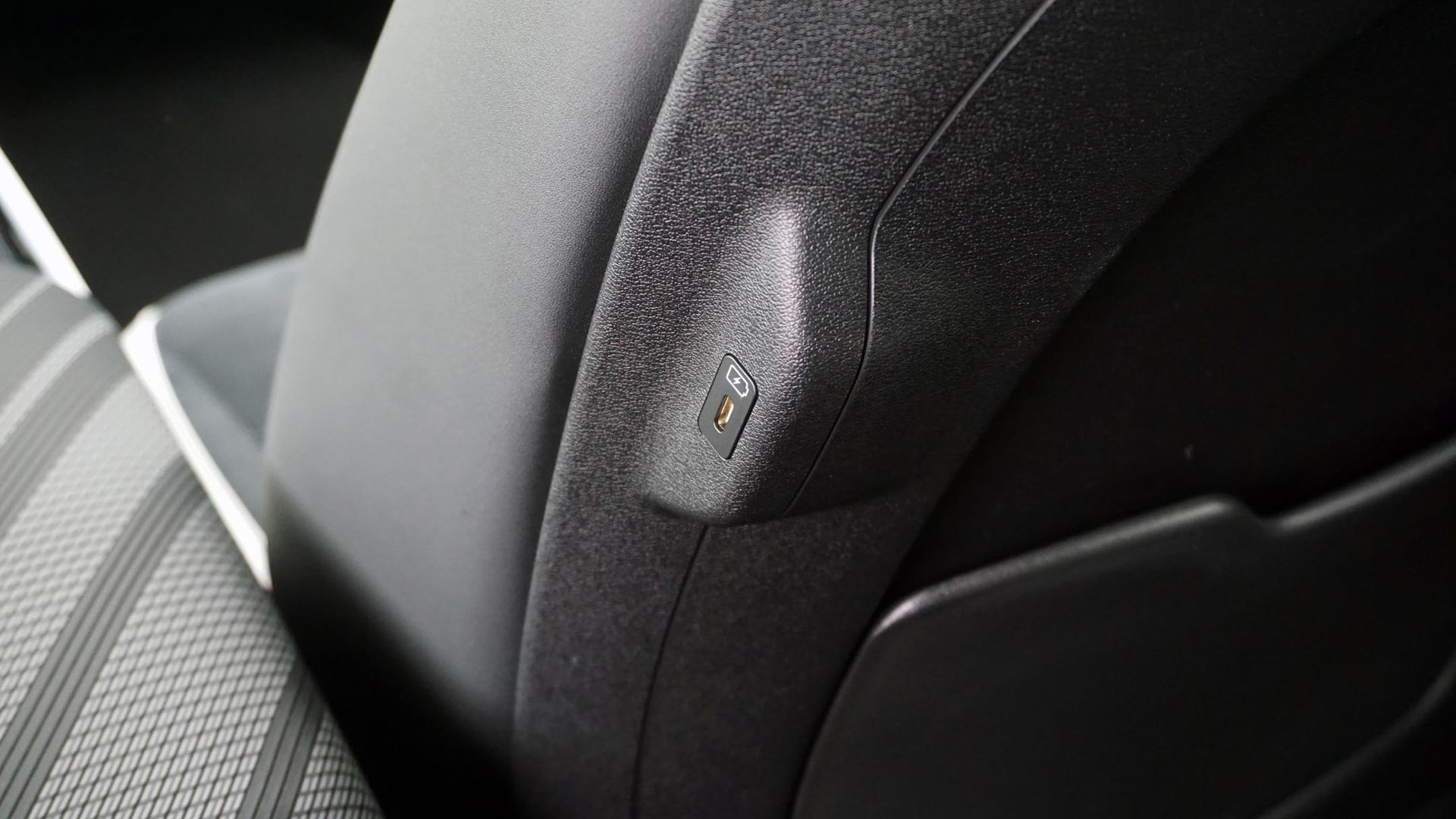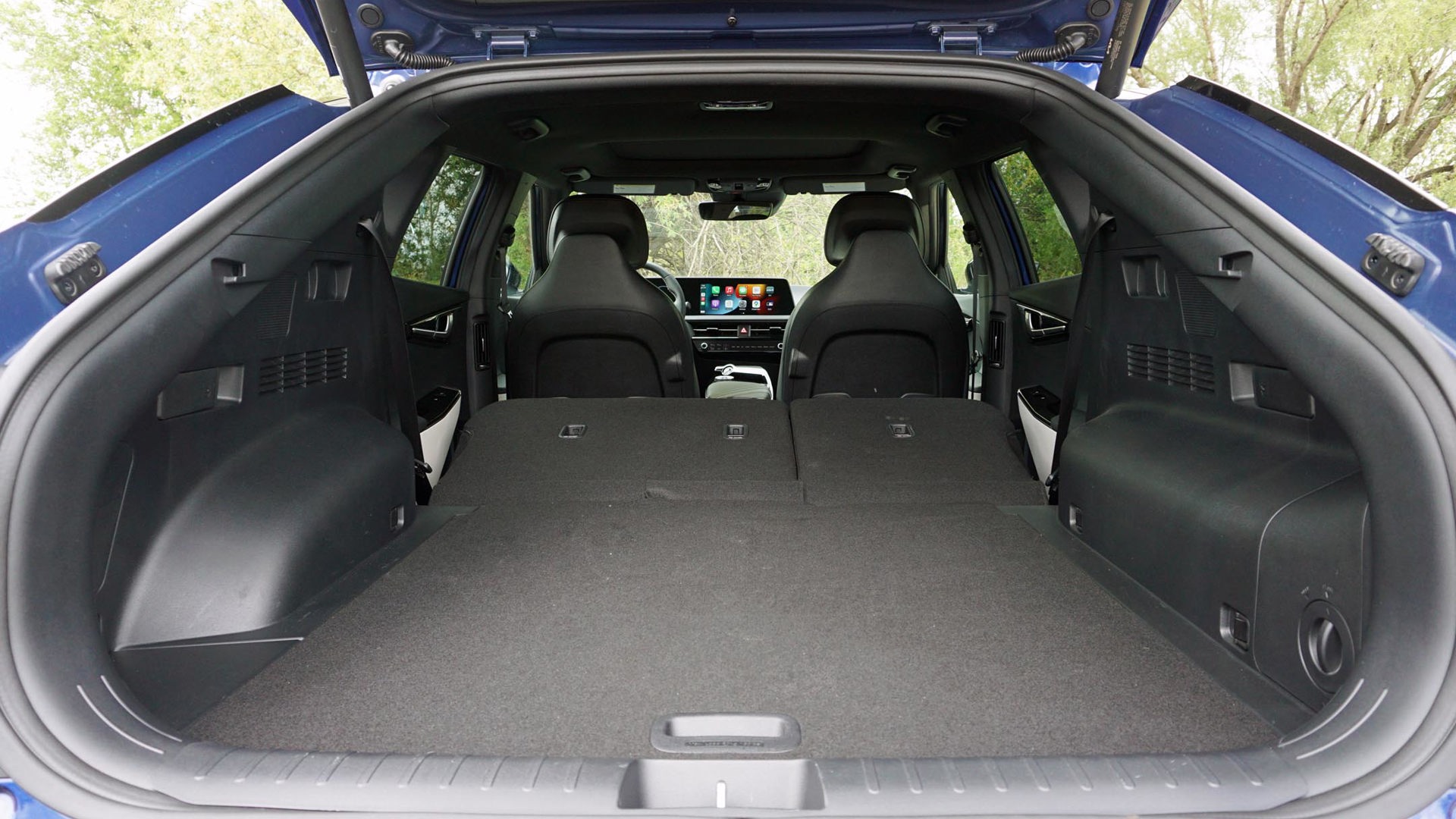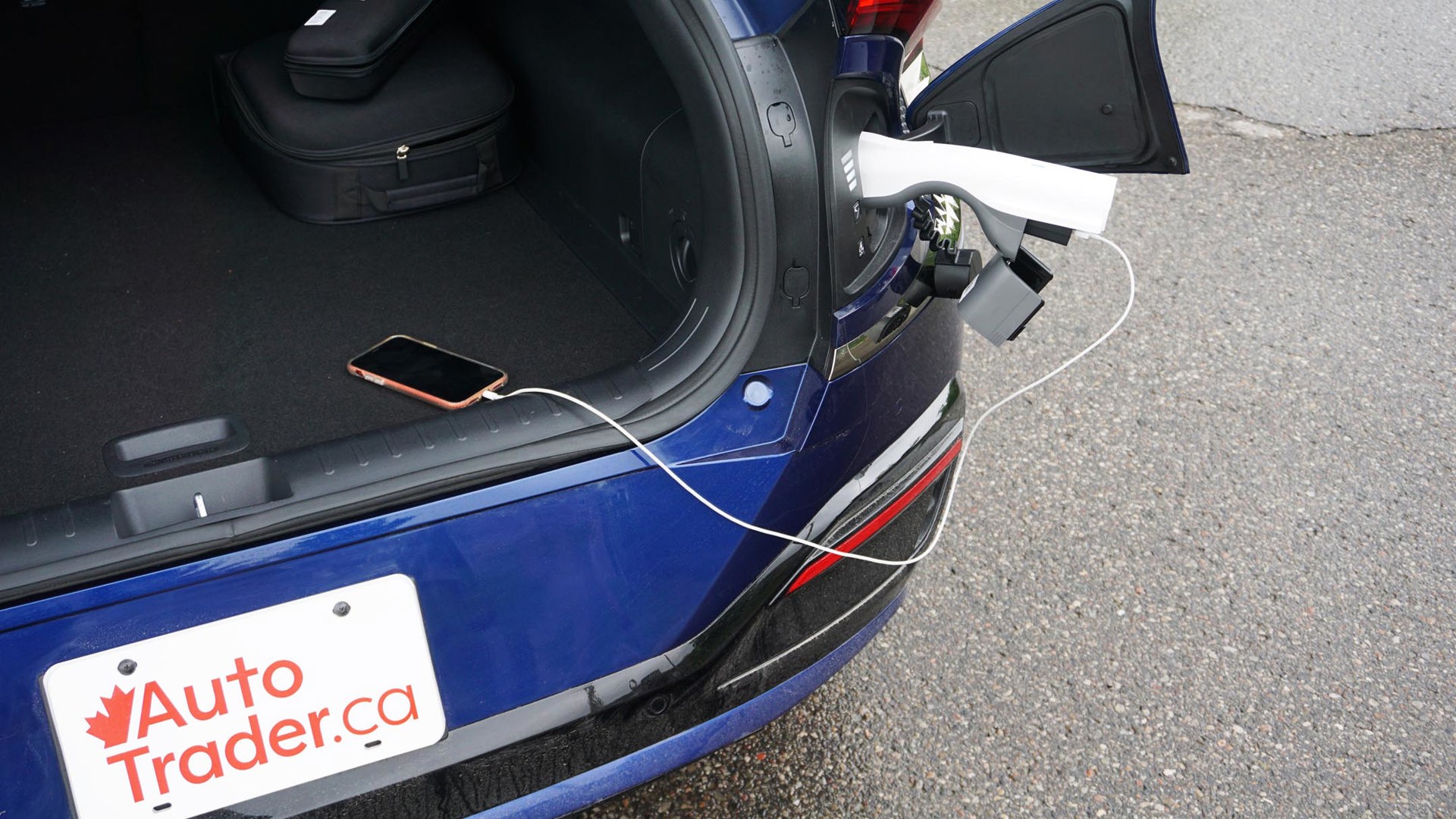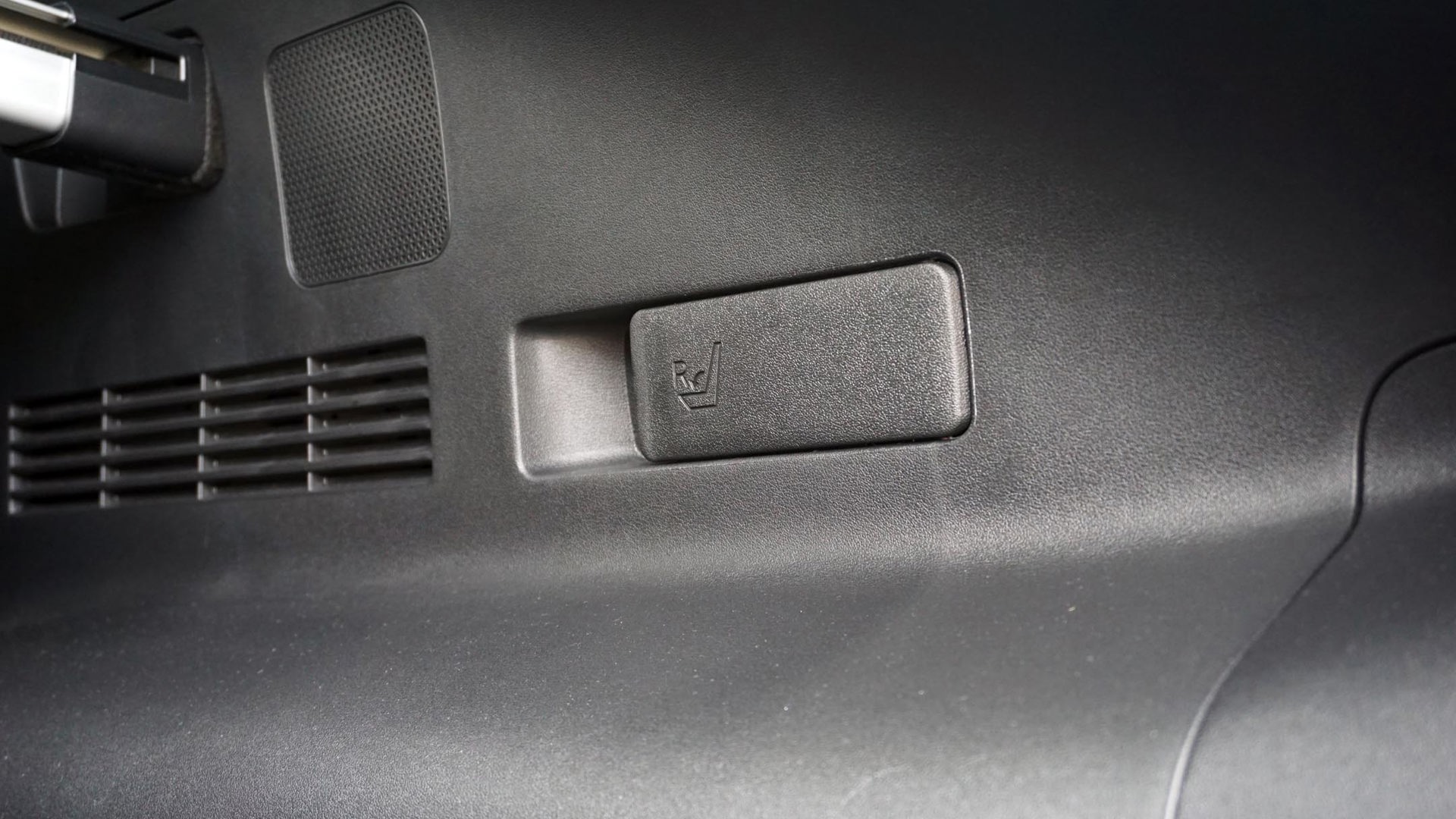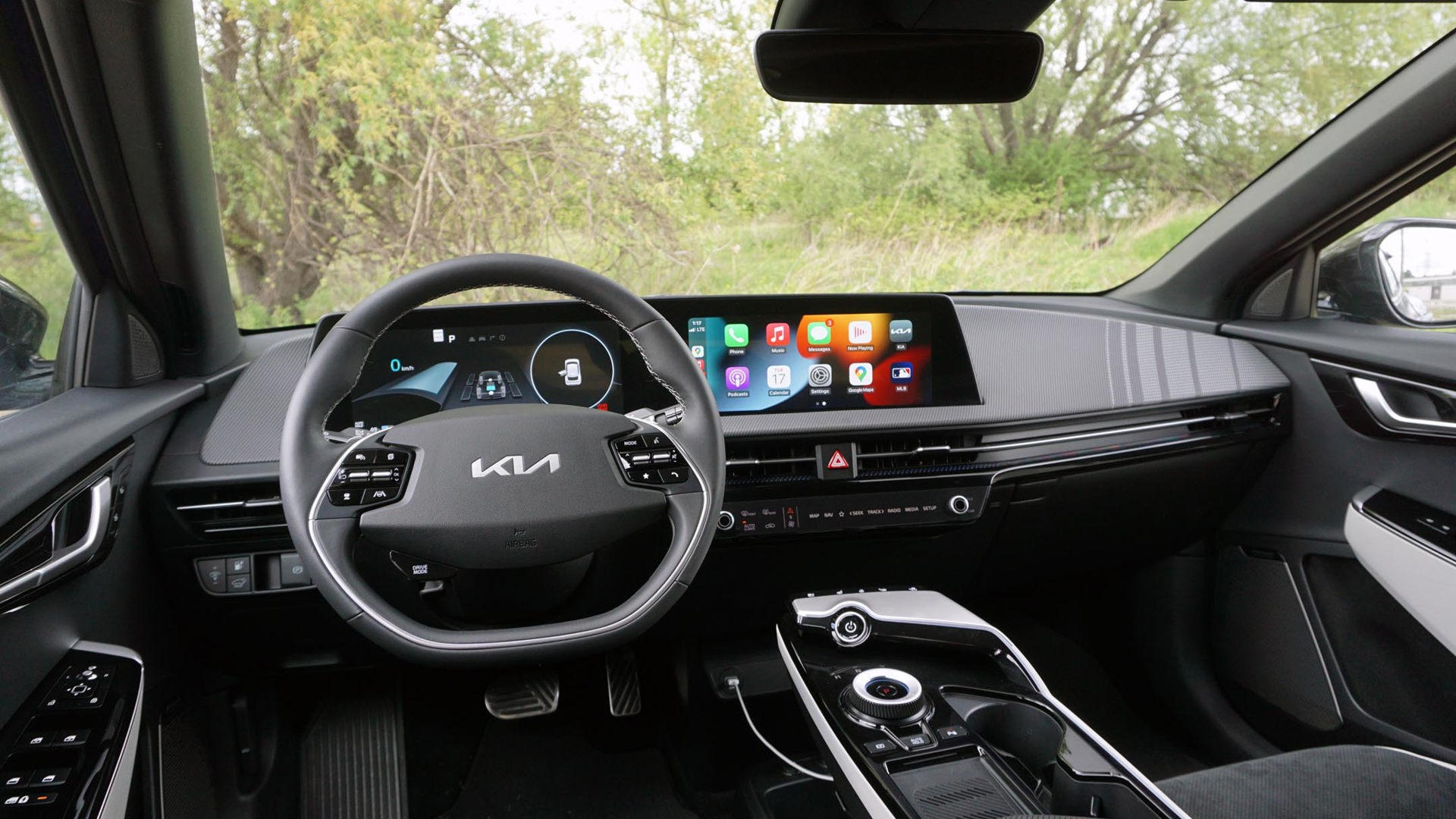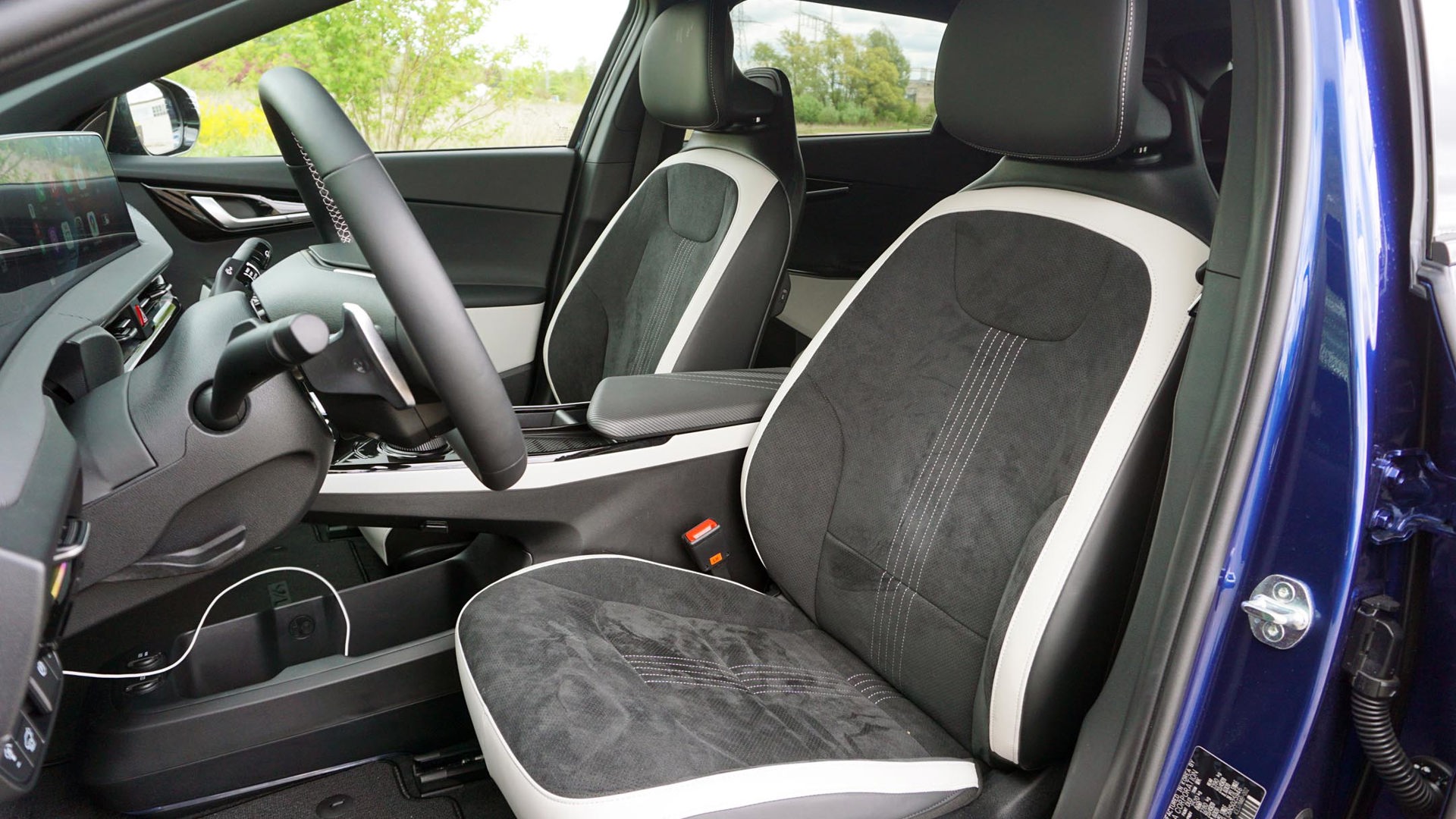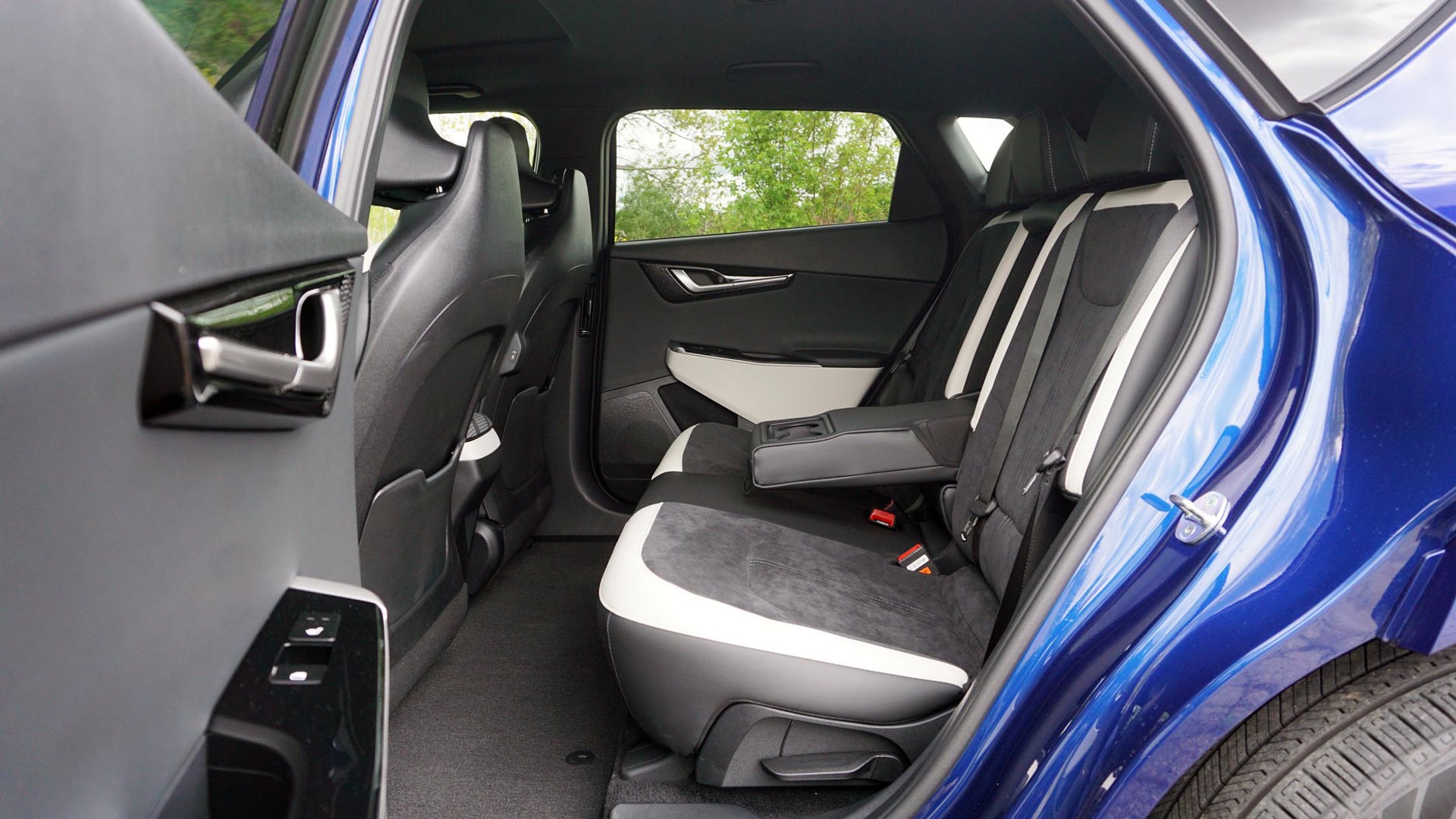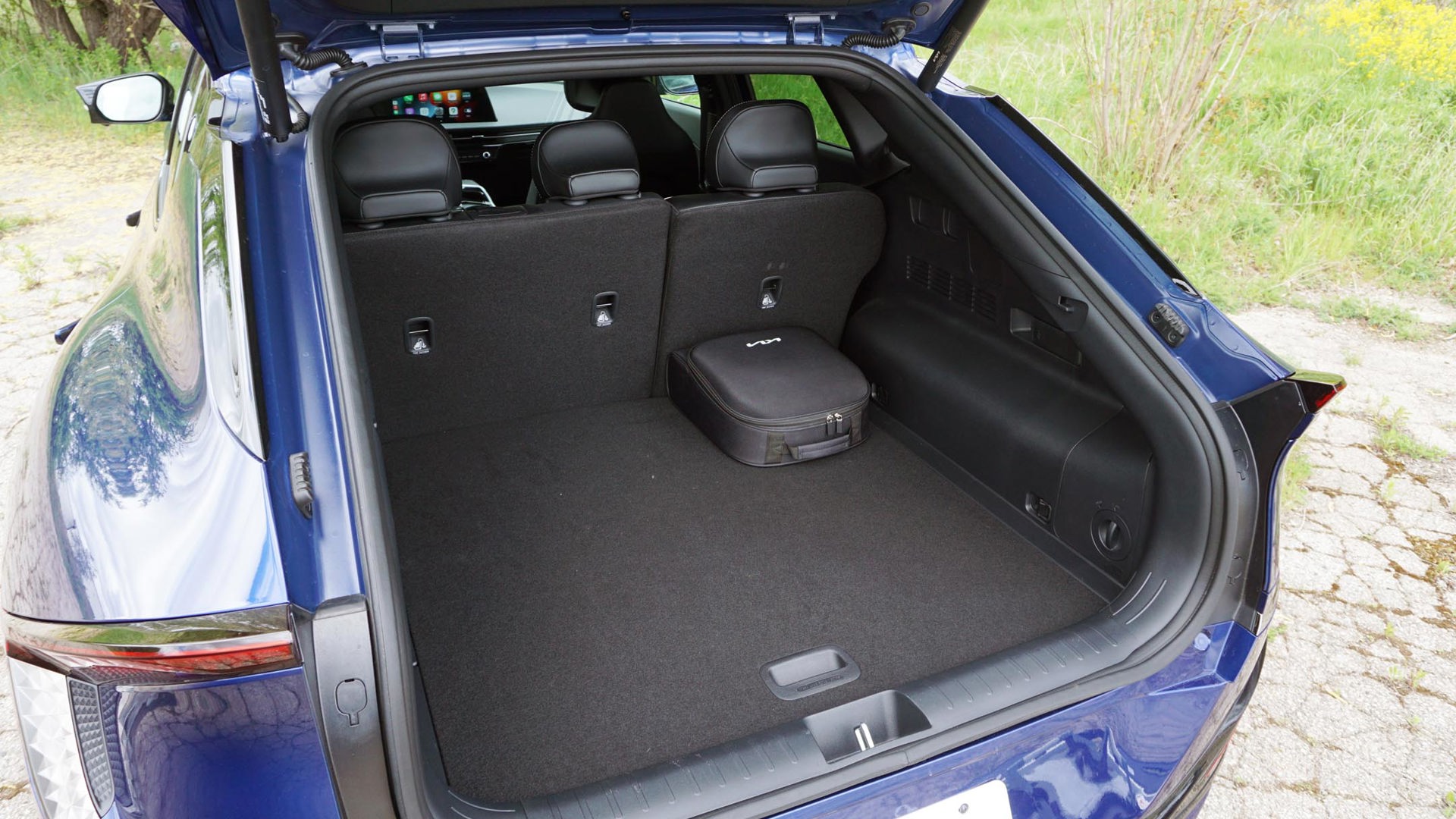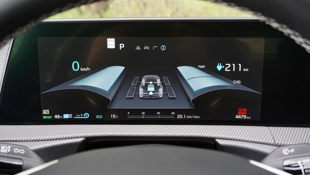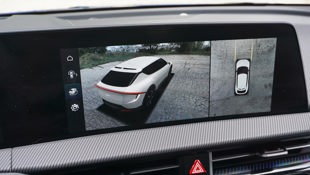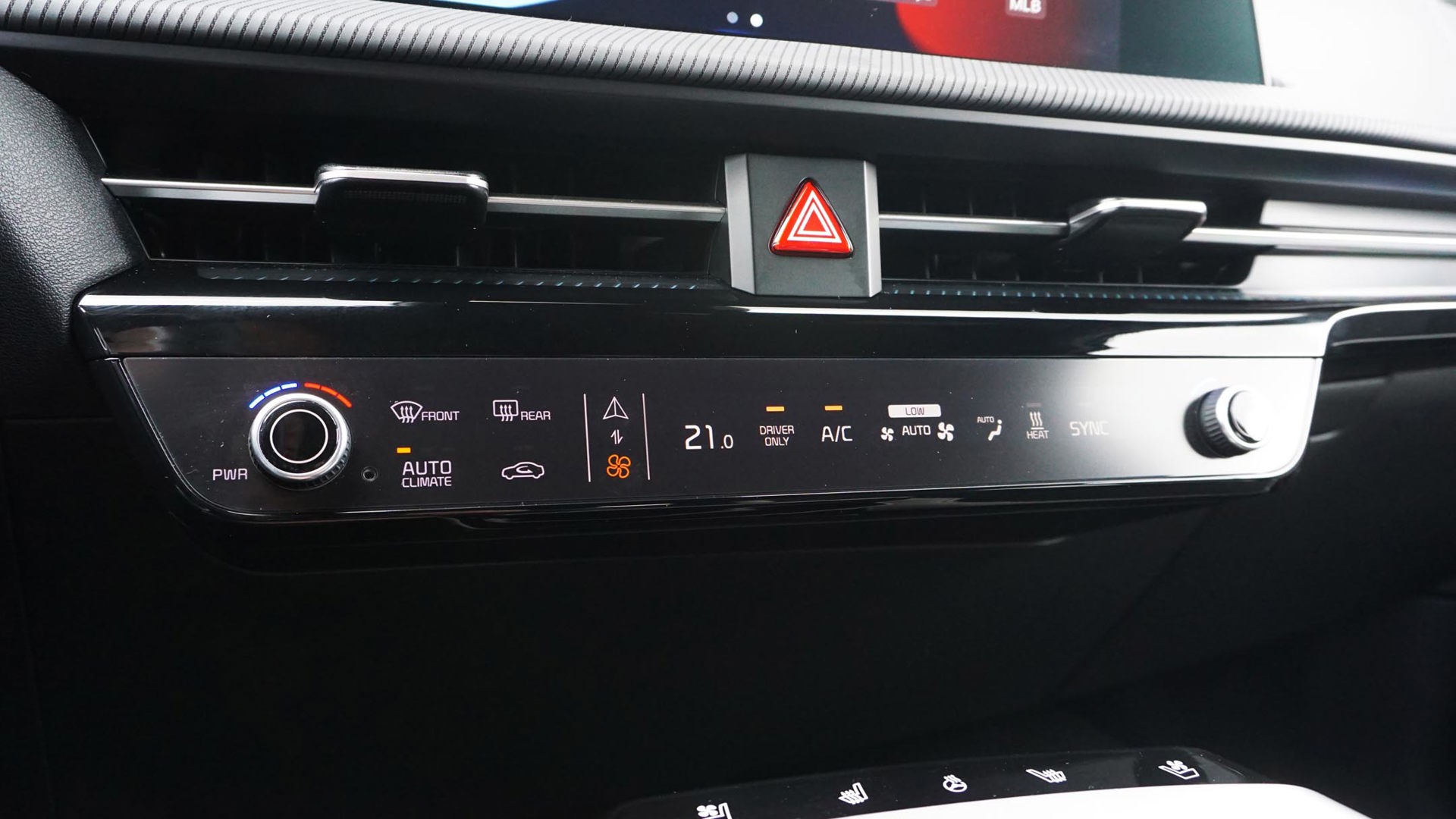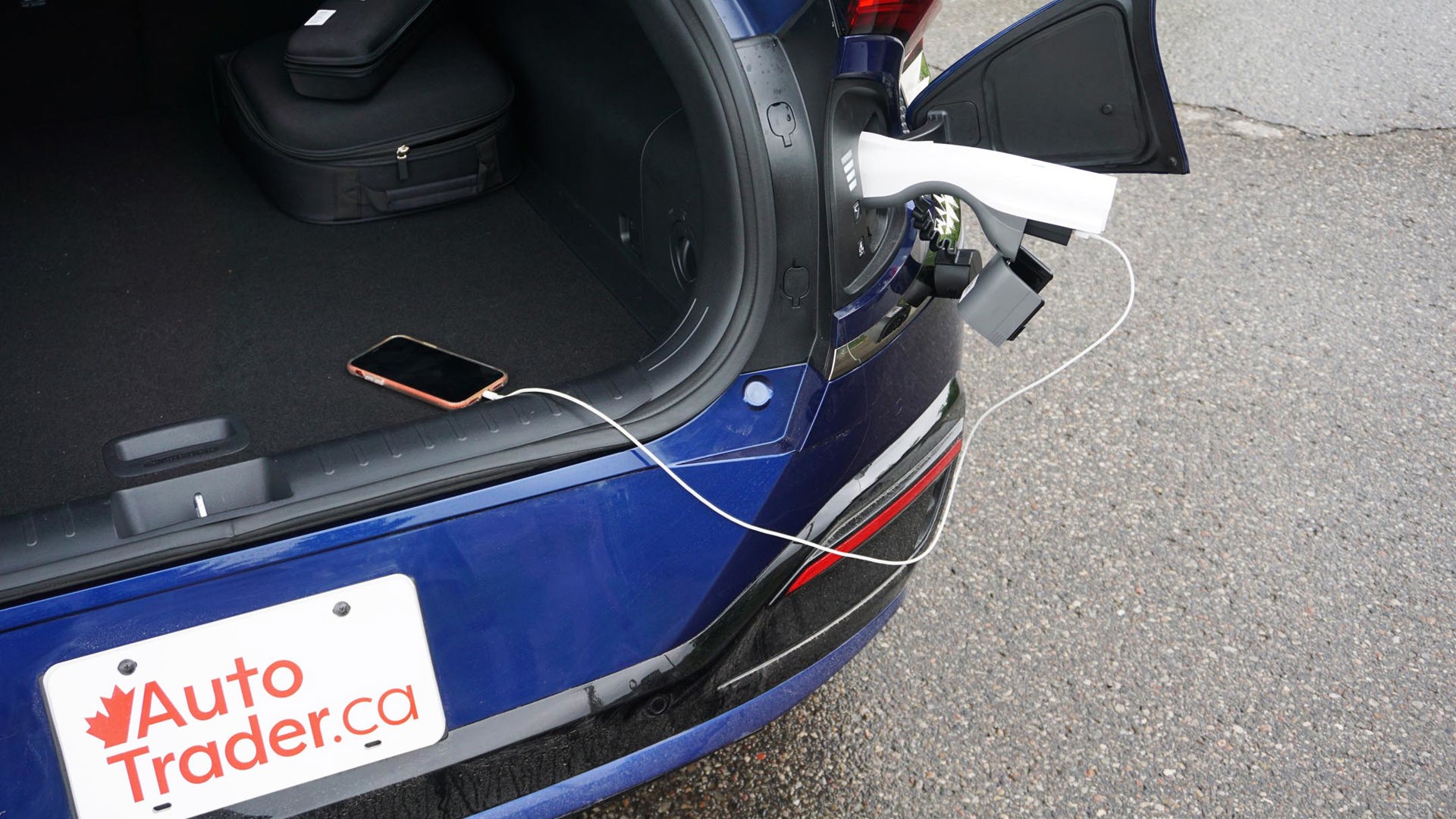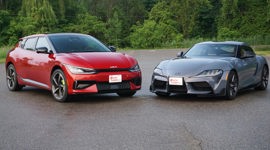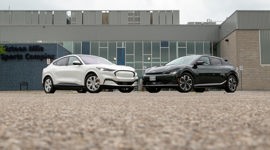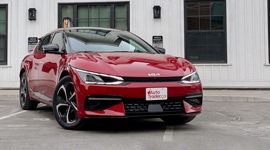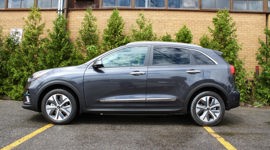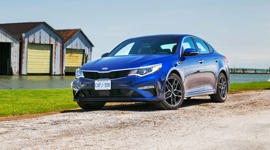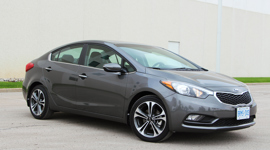 AutoTrader SCORE
AutoTrader SCORE
-
STYLING10/10
-
Safety9/10
-
PRACTICALITY8/10
-
USER-FRIENDLINESS7/10
-
FEATURES10/10
-
POWER10/10
-
COMFORT9/10
-
DRIVING FEEL10/10
-
FUEL ECONOMY10/10
-
VALUE7/10
Not many cars, electric or otherwise, attract attention like the 2022 Kia EV6.
The Hyundai Ioniq 5 comes close – ironic considering all they have in common. That includes a smattering of shortcomings that should be considered carefully before zeroing in on a purchase. Make no mistake: this is a very good electric vehicle (EV). But it’s also a few missteps short of being great.
Styling: 10/10
“Be honest,” the driver of the Chevrolet Bolt shouted as we waited side-by-side at a red light, “is that the coolest car you’ve ever driven or what?”
That was one of many similar comments and conversations the EV6 initiated during this week-long test, with its combination of rarity and daring design triggering all sorts of praise from passersby. Where the Ioniq 5 features retro-futuristic styling this is strictly about the latter, with a look that’s sleek, sporty, and undeniably unique. The wide rear haunches are similar to those of a Porsche – high praise for any mainstream car, let alone a Kia – while approach lights beneath the spoiler ends and a cluster of reverse lights under the back bumper provide an extra set of special touches.
The cabin is equally streamlined and stylish, with no clutter to contend with, just slick shapes and patterns spanning the dash, doors, and seats – particularly with the range-topping GT-Line package. Suede seating surfaces with contrast stitching and piping convey a certain sense of sportiness, yet the bolstering is minimal, ensuring cruising comfort for a broad selection of body types and sizes.
Comfort: 9/10
Such compliments are rare for Kia, a brand that isn’t exactly renowned for its seating. While the likes of the Seltos subcompact crossover still suffers from those afflictions – really, it’s the occupants who suffer – this EV remained pleasant even during a roughly six-hour evaluation drive spanning an assortment of city, highway, and rural roads, some of which manage to bring out the worst in otherwise outstanding automobiles.
Usually making matters worse for EVs like this one is the lack of mechanical white noise that’s generated, the silence in which they cruise around amplifying outside interference. And while some wind noise made its way inside while pushing ahead through some particularly strong gusts, it didn’t stand out as exceptional. However, the ride quality did in all the best ways possible.
Driving Feel: 10/10
When it comes to cruising comfort, there’s an inherent advantage to the very complexion of EVs, with their heavy battery packs requiring amped up damping rates that smoothly absorb road imperfections. That’s certainly the case with this Kia, and not even this tester’s 20-inch wheels and low-profile tires could do much to unsettle occupants over broken pavement.
The drive truly is the highlight of this electrified ride, with tremendous smoothness and ease of operation coming together with enough agility and quickness to be something for everyone. Looking for a hassle-free and efficient first foray into electrification? The EV6 does that as well as anything out there. Want some of the excitement that EVs are known for thanks to instant torque delivery and that low centre of gravity? Yep, this Kia does that for you, too.
But it also feels refined and responsive in ways that extend beyond what’s expected from mainstream models. There’s an inherent sportiness here that the electrically identical Ioniq 5 is missing, adding just enough engagement to the proceedings to make the EV6 enjoyable to drive in spite of its efficiency-first mandate.
Fuel Economy: 10/10
What a difference a few months makes. While the cold weather of an early February evaluation of the Ioniq 5 wreaked relative havoc on its range and efficiency, this springtime test of the Kia EV6 saw it outperform expectations, both official and otherwise. With its twin-motor all-wheel drive system, this tester’s consumption rate of 19.9 kWh/100 km is just so-so amongst modern EVs, although the 17.3 averaged across some 560 km of testing puts it in the company of some of the best models on the market. (It’s also more than 4.0 kWh/100 km better than a similar Ioniq 5 on paper and in practice.)
With its 77.4-kWh battery, this so-called AWD Long Range model is good for an estimated 441 km of driving range. That number still isn’t especially impressive – the rear-wheel-drive version with this same battery is rated for 499 km – but its ability to charge in a hurry is. Officially, Kia claims the EV6 can get from 10 per cent to 80 per cent on a DC fast-charger in 18 minutes. Considering charging slows down significantly beyond 80 per cent, the 42 minutes it took to get from 39 per cent to 99 per cent during testing is exactly the kind of quickness that makes a strong case for going electric.
Power: 10/10
So does the effortless way in which this dual-motor version delivers all its torque. Since that’s the stuff that gets this (or any other) vehicle moving, the combined 446 lb-ft of it split between the front and rear wheels smoothly adds speed as required – and it does so in a hurry. To provide some context, this version of the EV6 will get to highway speed from a standing start in about the same amount of time as the manual-equipped Volkswagen Golf R hot hatch.
Features: 10/10
Offered five ways in Canada, this Kia is typical of the brand in terms of the stuff it comes with. Although not much of it stands out these days, it doesn’t seem like the EV6 is missing much of anything, either. There’s even a USB-C port up front, which Kia and its compatriot brands under the Hyundai Motor Group banner have strangely shied away from.
Standard equipment across the lineup includes twin 12.3-inch displays, one of which is touch; a connected smartphone app that can lock and unlock the car, and even start and stop charging; Apple CarPlay and Android Auto connections; built-in navigation; satellite radio; dual-zone automatic climate control; and heated front seats. The so-called Long Range trims add useful features like a heat pump that recovers waste heat from the powertrain and uses it to warm the cabin, a heated steering wheel, memory settings for the driver’s seat, and a wireless phone charger, among others.
Opting for the priciest of two GT-Line packages adds meaningful features like an upgraded stereo, 20-inch wheels, suede upholstery, ventilated front seats, heated rear ones, and a power sunroof. It also adds so-called vehicle-to-load (V2L) technology that uses the car’s battery like an inverter through an outlet under the rear seats. (The car’s Level 1 charging kit also includes a V2L adapter that plugs into the charger port, allowing items to be plugged in outside.) That means small appliances or electronics can be plugged in, drawing as much as 1.9 kW from the system, while limits can be set in 20 per cent increments to ensure the battery isn't fully drained.
Safety: 9/10
Safety features abound, too, with seven airbags throughout the cabin, forward collision warning with pedestrian detection and automatic emergency braking, lane-keeping assistance, and adaptive cruise control that works in stop-and-go traffic. Both GT-Line packages add so-called blind-view monitoring that uses cameras in the door mirrors to project a live look at either side of the car in the instrument display, and a surround-view camera system, while the top-of-the-line pack also includes a head-up display.
The GT-Line packages add so-called junction-turn assist that warns of oncoming traffic when making a left turn, as well as the latest version of the Hyundai Motor Group’s highway drive-assist system that provides automated steering input. It also includes automatic lane-change functionality that reacts to signal inputs, although the changes themselves have to be the slowest around, while any perceived steering wheel adjustments will override the commands. With both hands required on the wheel anyway, it takes the novelty out of the technology altogether.
User Friendliness: 7/10
With so much that’s praise-worthy about the EV6, it’s hard to imagine it taking such a dramatic turn for the worse. And in fairness, it probably won’t for most shoppers out there, but special attention should be paid before putting a deposit down on this EV.
Just like with the Ioniq 5, the biggest issue is the lack of a rear window wiper. It’s one of the most bizarre exclusions in recent memory, and it’s also something of a growing trend amongst EVs, with the likes of the Subaru Solterra and its twin Toyota bZ4X – plus the premium Lexus RZ – also doing without the motorized apparatus. Apparently, Hyundai’s team is working to rectify the issue for next year, and it’s easy to imagine the same applies to the EV6; in the meantime, expect year-round visibility issues that spray-on repellent will only partially address.
Another shared issue amongst the EV6 and Ioniq 5 applies to tall drivers, and that’s the way the rim of the steering wheel obstructs the speedometer from view. While most digital instrument displays like this one offer selectable layouts that move drive-related information to various places, the location of the speedometer is frustratingly fixed in place.
There’s also the dual-function control panel below the infotainment screen that’s novel but adds an unnecessary step to infotainment and climate adjustment. Worse still, there’s no way to shut off the HVAC system completely using the controls; to do so requires accessing the climate menu via the infotainment screen.
Practicality: 8/10
Another problem exclusive to tall drivers is a serious lack of front-seat headroom here. Not shared with its counterpart from Hyundai, which uses a fixed glass roof instead of this pricey GT-Line package’s conventional powered panel, those of similar stature to your 6-foot-3 author will be forced to slouch awkwardly or have their heads dig uncomfortably into the sunroof’s frame. It also makes for something of a catch-22, with this most expensive EV6 the only one with a sunroof as well as the head-up display that projects a digital speedometer on the windshield, making the trouble with the instrument display obsolete at the cost of headroom.
The rest of the cabin is spacious and well sorted, and while cargo room is reasonable, too, at 690 L behind the back seats and 1,332 L with them upright, the sloping rear glass means the space is deeper than it is tall. In another puzzling packaging decision, only the most expensive version comes with a cargo privacy cover. Worse still, one isn’t offered as a stand-alone option.
Value: 7/10
Should such a simple feature be a prerequisite – not to mention the other must-haves like the head-up display, ventilated front seats, and V2L technology – expect to shell out some $61,995 for the EV6 AWD Long Range Gt-Line Package 2. That’s before its non-negotiable freight charge, too, which adds another $2,000 for a pre-tax price of $63,995 (add another $250 for any colour but black).
Skip those features and the GT-Line Package 1 is a $59,995 proposition, while sticking with the AWD Long Range on its own rings in at $56,995 before tax. There’s a pair of rear-wheel-drive trims, too, with the Long Range and its 499-km capability costing $54,995, and the Standard Range that can travel a claimed 373 km coming in at $46,995. All trims qualify for the full $5,000 federal EV rebate, while various provinces and territories offer further incentives that can be combined with the federal one.
Unsurprisingly, pricing is similar to that of the Ioniq 5, although this range-topper is actually a little more expensive than the priciest Hyundai. Competitors include the Volkswagen ID.4, Ford Mustang Mach-E, Chevrolet Bolt, and Tesla Model Y, among others, although the latter doesn’t qualify for the federal rebate. There’s also the Toyota bZ4X and Subaru Solterra that should be arriving in dealers not long after the time of this writing. It should be noted, however, that getting your hands on one could prove rather difficult.
The Verdict
Of course, the lack of headroom in the 2022 Kia EV6 isn’t going to be an issue for everyone (nor is it an issue with every trim); neither is the obstructed speedometer. But just like with the Hyundai Ioniq 5, the rest of the complaints are universal. The lack of a rear wiper or the way the climate system can’t be shut off without going through the infotainment screen, or even the way the hatch cuts into cargo room – they may be relatively minor annoyances, but they’re annoyances nonetheless.
On the other hand, the EV6 looks great inside and out, is amazing to drive, and comes with all kinds of features, decent driving range, and quick-charging capabilities that make it a desirable EV to own. That’s why the best advice for those who are serious about the idea of owning one is to get some hands-on time and see how those pain points test your patience before you get too excited about the idea of parking one in the driveway.
| Engine Displacement | 239 kW |
|---|---|
| Engine Cylinders | Dual electric motors |
| Peak Horsepower | 320 hp |
| Peak Torque | 446 lb-ft |
| Fuel Economy | 2.0 / 2.5 / 2.2 Le/100 km, 18.0 / 22.4 / 19.9 kWh/100 km cty/hwy/cmb; 441 km est. range |
| Cargo Space | 690 / 1,322 L seats up/down |
| Model Tested | 2022 Kia EV6 AWD Long Range |
| Base Price | $54,995 |
| A/C Tax | $100 |
| Destination Fee | $2,000 |
| Price as Tested | $64,345 |
|
Optional Equipment
$7,250 – GT-Line Package 2, $7,000; Yacht Blue Paint, $250
|
|
